- 1College of Energy, Chengdu University of Technology, Chengdu, Sichuan, China
- 2Civil-Military Integration Center of China Geological Survey, Chengdu, Sichuan, China
- 3Chengdu Center of China Geological Survey (Geosciences Innovation Center of Southwest China), Chengdu, Sichuan, China
The black mudstones of the Upper Triassic Bagong Formation, Qiangtang Basin, are important hydrocarbon source rocks, but significant differences are found in their quality across the region; thus, the genetic mechanism of these mudstones needs to be revealed to determine the spatial distribution of the high-quality hydrocarbon source rocks in the Bagong Formation of the North Qiangtang Depression. To elucidate the genetic mechanism of the Bagong Formation mudstones, 31 samples of the Bagong Formation mudstones from the Tielong Section in the eastern North Qiangtang Depression were collected and analysed to determine their total organic carbon (TOC) and major and trace element contents. The results revealed that the Bagong Formation mudstones in the study area had a low to moderate TOC contents; these results indicated that they were poor to moderate hydrocarbon source rocks. The elemental geochemical characteristics indicate that the provenance of the Bagong Formation mudstones in the study area was mainly felsic rocks that formed in collisional tectonic settings; these results are consistent with the tectonic regime of early Late Triassic intracontinental compression in the North Qiangtang Depression. During the deposition of the Bagong Formation mudstones, the climate was warm and humid, and the environment was a shallow oxidizing saltwater column, with a large input of rapidly deposited fine-grained argillaceous detritus. The warm and humid climate conditions and rapid sedimentation rate during the deposition of the Bagong Formation mudstones in the study area promoted the preservation of partly organic matter; however, the overall abundance of organic matter remained low because of the influence of the oxidizing water column.
1 Introduction
The Qiangtang Basin is located in the eastern section of the Tethys tectonic domain and features the most abundant oil and gas resources in that domain. Its adjacent western section is the Middle East oil and gas region, and the southeastern section is the Southeast Asian oil and gas region. This unique tectonic setting has drawn significant attention from petroleum geologists, and the Qiangtang Basin in China’s Qinghai‒Tibet Plateau is an optimal area, with the greatest potential for strategic breakthroughs in oil and gas resources (Tan et al., 2002; Wang et al., 2004; 2009; 2020; Wu et al., 2014). With the continuous advancement of oil and gas exploration in the Qiangtang Basin in recent years, widely distributed and high-quality argillaceous hydrocarbon source rocks and oil and gas shows have been discovered in the Upper Triassic strata using surface outcrop investigations and exploratory wells for geological survey; these discoveries have established Upper Triassic strata as the primary target layer for oil and gas exploration in the Qiangtang Basin. In addition, the recently completed Qiangke one well in the hinterland of the North Qiangtang Depression features a significant gas logging anomaly, where the total hydrocarbon content has increased from 0.044% to 3.544%; this depression is located in the pyroclastic rocks of the Upper Triassic Nadigangri Formation within the well interval of 4,246.0–4,253.7 m, and the underlying Upper Triassic strata are the possible gas sources (Wang J. et al., 2022).
Global oil and gas exploration practices have confirmed that the quality of hydrocarbon source rocks fundamentally controls the distribution of oil and gas resources and the formation of large oil and gas fields; this research topic has attracted extensive attention from scholars worldwide. In particular, the study of the genetic mechanism of black mudstone has become a cutting-edge research topic in the field of earth sciences (Pedersen and Calvert, 1990; Gallego-Torres et al., 2007; Wei et al., 2012; Lash and Blood, 2014; Qiu et al., 2019). The black mudstones of the Upper Triassic Bagong Formation in the eastern North Qiangtang Depression are widely distributed and commonly found in delta-shallow marine shelf environments. However, their qualities and hydrocarbon generation potentials are significantly different (Zeng et al., 2013; Song et al., 2018; Wang et al., 2021; 2022b; Sui et al., 2025). Therefore, determining the spatial distribution of high-quality hydrocarbon source rocks in the Upper Triassic Bagong Formation is a crucial prerequisite for the next phase of oil and gas exploration. In particular, the process of organic matter enrichment in hydrocarbon source rocks and its controlling factors are key to predicting high-quality hydrocarbon source rocks. Since the factors controlling organic matter enrichment are unclear and the depositional environment is poorly understood, the range of distribution of hydrocarbon source rocks is difficult to delineate and predict. However, the genetic mechanism of black mudstones is controversial, and the primary debate is centred on whether organic matter enrichment is controlled by initial productivity (Pedersen and Calvert, 1990; Sageman et al., 2003; Wei et al., 2012), preservation conditions (Demaison and Moore, 1980; Canfield, 1994; Yan et al., 2009; Zeng et al., 2015), or a combination of both factors (Algeo and Tribovillard, 2009; Ross and Bustin, 2009; Wang et al., 2017; Li et al., 2025).
Previous studies on the genetic mechanism of the Upper Triassic Bagong Formation black mudstones have focused mostly on the 1:250,000 scale Chibuzhangcuo area (Yu et al., 2019; Wang et al., 2022c); however, studies on its eastern Wenquanbingzhan area are limited, creating an unfavourable situation for delineating and predicting the spatial distribution of hydrocarbon source rocks in this area. Therefore, in this study, the black mudstone of the Bagong Formation in the Tielong Section of the Wenquanbingzhan area in the eastern North Qiangtang Depression is used as the research object to carry out total organic carbon (TOC) and element geochemical analyses to determine the sedimentary provenance and tectonic attributes of the Bagong Formation black mudstone. On this basis, we reconstruct the paleoenvironmental conditions, such as palaeoclimate, palaeo-redox conditions, palaeowater depth and palaeosalinity, of the shale depositional period to reveal the genetic mechanism of this set of mudstones and provide a basis for predicting the distribution of high-quality hydrocarbon source rocks in the Bagong Formation.
2 Regional geological setting
The Qiangtang Basin is located in the north–central Qinghai‒Tibet Plateau and is tectonically adjacent to the Tarim Block, Kunlun Block, Hoh Xil Block, Songpan‒Ganzi Block and Lhasa Block. Previous geological and geophysical data indicate that the southern and northern boundaries of the basin are the Bangong Lake–Nujiang Suture Zone and the Hoh Xil–Jinsha River Suture Zone, respectively (Figure 1A; Wang et al., 2004); from south to north, the basin can be further divided into the following three secondary structural units: the South Qiangtang Depression, the Central Uplift Zone and the North Qiangtang Depression; these units form a structural pattern of two depressions flanking one uplift (Figure 1A; Wang et al., 2004; Xiong et al., 2020). However, the latest aeromagnetic data show that the South and North Qiangtang regions have completely different gravity and magnetic field characteristics; these results indicate that they are two entirely different structural units, whereas the Central Uplift Zone is a suture zone formed by the closure of the Longmucuo–Shuanghu Palaeo-Tethys Ocean during the Late Triassic (Xiong et al., 2020). During the early to middle Late Triassic (Carnian–Norian), influenced by the closure and collisional orogeny of the Hoh Xil–Jinsha River and Longmucuo–Shuanghu Palaeo-Tethys Oceans, the North Qiangtang Depression was under a strong compressional environment, and a composite foreland basin subsequently formed (Shen et al., 2024). With the large-scale regression caused by the closure of the Palaeo-Tethys Ocean, the North Qiangtang foreland basin gradually shrank and was filled sequentially from bottom to top with the Upper Triassic Jiapila Formation, Bolila Formation, and Bagong Formation (Wang et al., 2009).
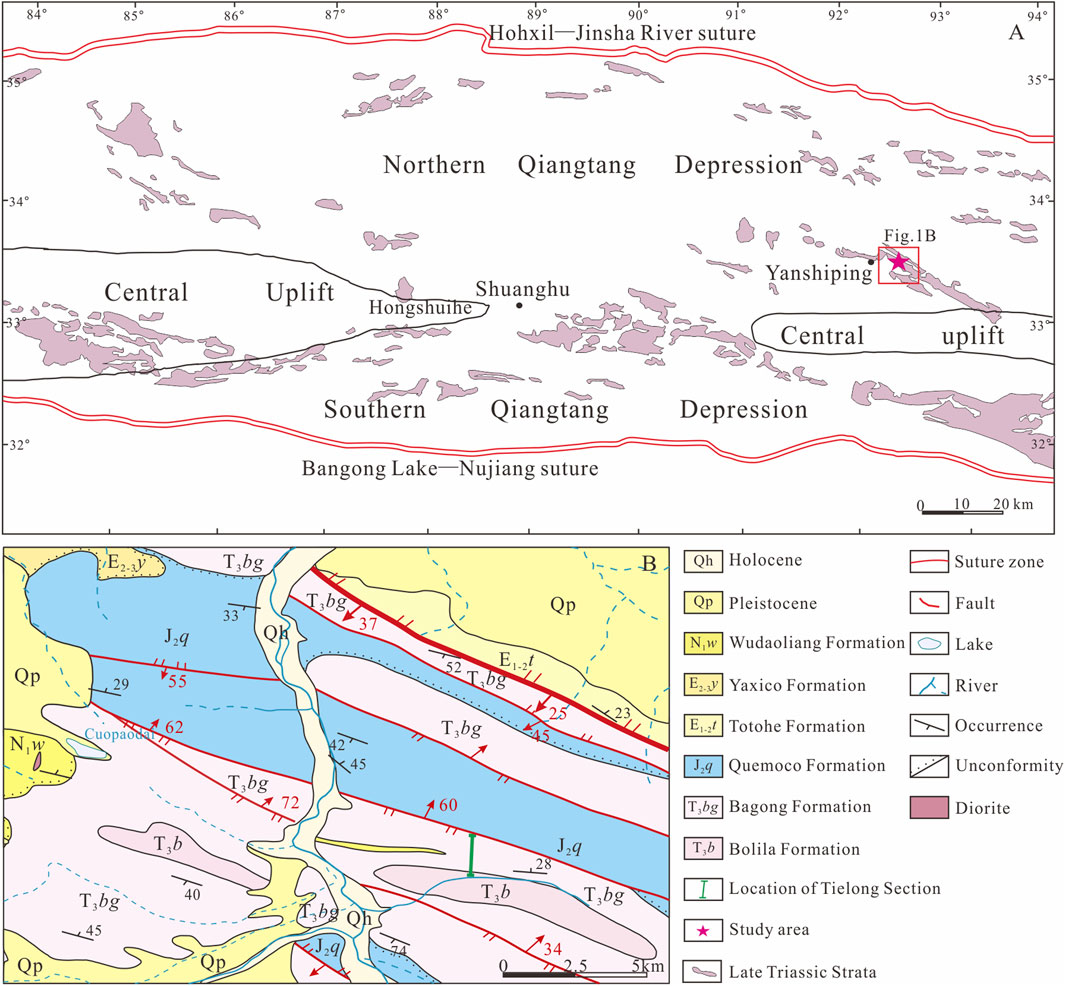
Figure 1. (a) Tectonic framework of the Qiangtang Basin; (b) Brief geologic map of the Tielong section.
The Tielong Section in the study area is located east of the Yanshiping subsag in the eastern North Qiangtang Depression, with the section starting at E92°32′29.99″, N33°36′19.78″(Figure 1B); additionally, the exposed Upper Triassic Bagong Formation exceeds a thickness of 326.45 m and is in conformable contact with the underlying Bolila Formation, and its top is not exposed (Figure 2). In terms of lithological assemblage, the Tielong Section consists of interbedded grey‒greyish-green–light grey medium-bedded siltstone, greyish‒ black–dark grey‒grey thin-bedded mudstones with varying thicknesses, and grey medium-bedded lithic sandstone (Figure 2). Vertically, the grain size of clastic rocks gradually coarsens upwards and forms an overall progradational inverse grading sequence. Normally graded bedding, parallel bedding, and groove and gutter casts are present in the sandstone, thin-layer conglomerate is present in the siltstone, and the mudstone features horizontal bedding and horizontal trace fossils (Figure 2). On the basis of the sedimentary characteristics of the Bagong Formation in the adjacent Dongqu area, this sequence likely represents slump–turbidite facies in the proximal delta front (Zhan et al., 2019). Regionally, the lower part of the Bagong Formation contains Carnian bivalve species (Halobia convexa and H. yunnanensis), early and middle Norian species (Halobia superbescens, H. disperseinsecta, Amonotis togtonheensis, and Cardium (Tulongocardium) xizhangensis) and ammonite species (Nodotibetites cf. Nodosus, and Paratibetites cf. Wheeleri) (Niu et al., 2003; Tang et al., 2007), whereas the upper part of the Bagong Formation contains Carnian–Norian bivalve species (A. rothpletzi yushuensis, Bakevellia pannonica and Costatoria goldfussi). Recently, researchers have constrained the stratigraphic age of the Bagong Formation from different perspectives. For example, the detrital zircon dating of sandstones at the top of the Bagong Formation obtained from the Quemocuo area yields the youngest zircon ages ranging from 217 to 227 Ma, with a weighted mean age of 222.0 ± 1.5 Ma (n = 9), whereas the detrital zircons from the upper sandstones of the Bagong Formation in Well QZ-16 yield ages between 223 Ma and 229 Ma, with a weighted mean age of 227.2 ± 1.2 Ma (n = 19; Zeng, 2021). On the basis of the biostratigraphic characteristics of the Bagong Formation and the maximum depositional ages of detrital zircons, its age is estimated to be Carnian–Norian of the Late Triassic.
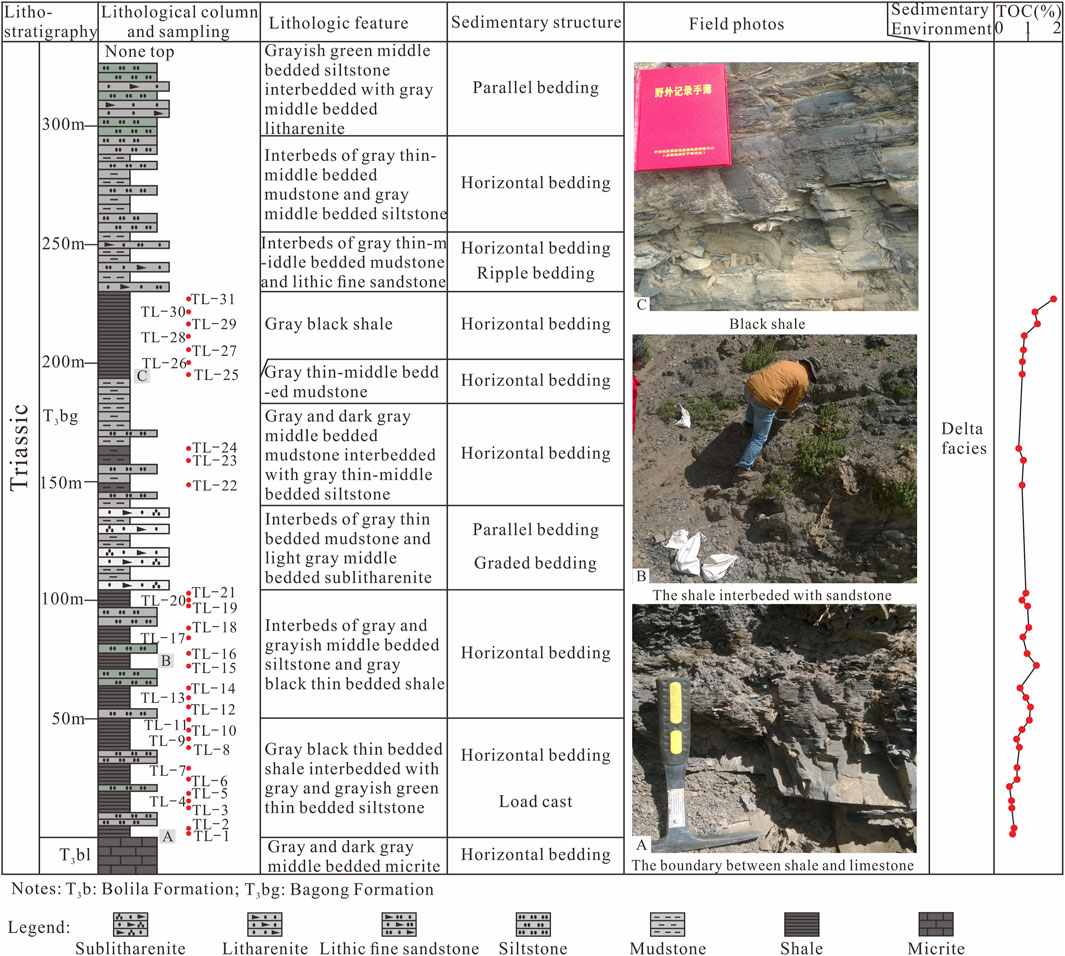
Figure 2. Sedimentary characteristics of the Upper Triassic Bagong Formation from the Tielong section and showing sampling locations and vertical distributions of total organic carbon (TOC) contents.
3 Samples and methods
In this study, 31 dark mudstone samples were collected from the bottom to the top of the Bagong Formation in the Tielong Section, and the specific sampling locations are shown in Figure 1C. Systematic TOC and element geochemical analyses were carried out on 31 mudstone samples to reconstruct the sedimentary palaeoenvironment and identify its origin.
The TOC and sulfur contents were measured with a LECO CS-200 carbon–sulfur analyser at the Organic Geochemistry Laboratory of Yangtze University, with an error of less than 10%. Detailed processes were presented in Peters and Cassa (1994). Major elements were analysed using the fusion method. A total of 0.5 g of whole-rock powder (200 mesh) and 5 g of flux (Li2B4O7:LiBO2 = 12:22) were weighed and evenly mixed in a crucible made of 95% platinum–5% gold, and the sample was heated in a high-frequency melting furnace at 1,050 °C for 11 min. The molten liquid was poured into a mould (diameter = 34 mm) to form a fused disc for testing. The samples were tested using a Philips PW2404 X-ray fluorescence spectrometer according to the GB/T 14,506.28–2010 standard. The loss-on-ignition was determined by weighing 1 g of dry powder sample into a corundum crucible, heating it in a muffle furnace at 1,000 °C for 90 min, cooling it in the furnace, weighing it, and recording the loss-on-ignition during heating. Trace elements were analysed using mainly the acid dissolution method. A total of 0.5 g of dried whole-rock powder was weighed and placed in a Teflon crucible. The sample was wetted with one to two drops of high-purity water; 1.5 mL of high-purity nitric acid and 1.5 mL of high-purity hydrofluoric acid were then sequentially added, and the sample was sealed in a steel jacket and heated in an oven at 190°C ± 5°C for 48 h. After cooling, the crucible was uncovered and placed on an electric hot plate to evaporate any remaining liquid in the sample at a constant temperature of 140 °C. Then, 1 mL of HNO3 was added to the sample and then evaporated; next, 3 mL of 30% HNO3 was added to the sample, and the sample was resealed in a Teflon crucible in a steel jacket and heated in an oven at 190°C ± 5°C for 12 h. The solution was then transferred to a polyethylene bottle, diluted with 2% HNO3 to 100 g (dilution factor of 2,000), and sealed for testing. The trace element contents were determined according to GB/T 14,506.30-2010 using a Finnigan MAT high-resolution inductively coupled plasma–mass spectrometer (HR–ICP–MS). Major and trace element analyses were conducted at the Beijing Research Institute of Uranium Geology, and the relative standard deviations were less than 5%. More analytical processes of major and trace elements were following the methods described by Ma et al. (2015).
4 Results
4.1 TOC contents of the upper triassic Bagong Formation mudstones
The TOC contents of 31 mudstone samples from the Tielong Section of the Bagong Formation significantly fluctuate and range from 0.47% to 1.73% (Supplementary Table S1), with an average of 0.87%. Among the samples, the TOC contents are less than 0.5% for one sample, greater than 1.0% for seven samples, and between 0.5% and 1.0% for the remaining 23 samples. Vertically, the overall TOC content initially increases, then decreases, and finally increases again, and the highest TOC content occurs at the top (Figure 2).
4.2 Element geochemical characteristics of the upper triassic Bagong Formation mudstones
4.2.1 Major elements
The major element contents of the Bagong Formation mudstones in the Tielong Section are listed in Supplementary Table S1. In the studied samples, the most abundant oxides are SiO2 and Al2O3, with contents of 53.77%–61.31% and 14.45%–19.75%, respectively, followed by Fe2O3, MgO, K2O, and CaO, with contents of 5.81%–7.09%, 2.35%–2.74%, 2.85%–4.64%, and 1.33%–3.05%, respectively; the contents of the other oxides are generally less than 1%. Ross and Bustin (2009) proposed that SiO2, Al2O3, and CaO can be used to represent siliceous, argillaceous and calcareous materials, respectively, to distinguish different shale/mudstone types. In the SiO2–Al2O3–CaO ternary diagram (Figure 3), the samples from the study area have significantly higher SiO2 contents than CaO and Al2O3 contents, and all the samples are located in the SiO2 end-members; these results indicate that the Bagong Formation mudstones from the Tielong Section are characterized by high silica contents.
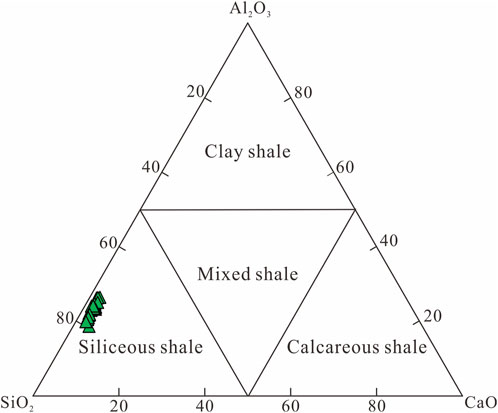
Figure 3. SiO2-Al2O3-CaO triangle diagram of the Bagong Formation mudstones from the Tielong section, Eastern Qiangtang Basin (modified after Ross and Bustin, 2009).
For the oxides in the Bagong Formation in the study area, K2O has a significant positive correlation with Al2O3 (R = 0.99, n = 31; Supplementary Table S2) but a significant negative correlation with Na2O (R = −0.95, n = 31; Supplementary Table S2); these results indicate that K2O primarily originates from clay minerals, which from the alteration of feldspar, rather than directly from feldspar minerals (Ross and Bustin, 2009). Fe2O3T and MgO are significantly correlated with Al2O3 (R = 0.67 and 0.84, respectively; n = 31; Supplementary Table S2), whereas no correlation is observed between MgO and CaO (R = −0.23, n = 31; Supplementary Table S2); these results indicate that Fe2O3T and MgO have similar properties and are derived mostly from terrigenous detritus rather than carbonate minerals. A significant positive correlation is observed between the TiO2 and Al2O3 contents (R = 0.89, n = 31; Supplementary Table S2); these results show that Ti is derived from mainly terrigenous detritus and occurs in clay minerals in the form of heavy minerals. A significant negative correlation is observed between SiO2 and Al2O3 contents (R = −0.94, n = 31; Supplementary Table S2); thus, Si originates from nonclay minerals and may occur mainly in detrital quartz.
4.2.2 Trace and rare earth elements
The trace element results for the Bagong Formation mudstones in the study area are provided in Supplementary Table S3. The contents of the large-ion lithophile elements Rb, Sr, Cs, Ba, Pb, Th and U in the mudstone are 142–210 ppm, 73.1–97.5 ppm, 10.2–19.7 ppm, 427–648 ppm, 24.4–74.4 ppm, 13.5–18.6 ppm, and 2.76–3.80 ppm, respectively (Supplementary Table S3). In the samples, the Al2O3 contents are significantly positively correlated (Supplementary Table S2) with the Rb (R = 0.96, n = 31), Cs (R = 0.86, n = 31), Ba (R = 0.88, n = 30), Th (R = 0.91, n = 31), and U contents (R = 0.73, n = 30); these results indicate that these elements are sourced mainly from terrigenous detritus and occur mostly in clay minerals. However, the Al2O3 content is not significantly correlated with the Sr or Pb contents (R = −0.2 and 0.16, respectively, n = 31; Supplementary Table S2), indicating that Sr and Pb are not derived from detritus. The contents of high-field strength elements Nb, Ta, Zr, and Hf in the Bagong Formation mudstones of the study area are 16.3–19.4 ppm, 1.16–1.40 ppm, 124–196 ppm, and 3.71–6.52 ppm, respectively (Supplementary Table S3). Significant positive correlations are observed between Nb and Ta (R = 0.88, n = 31), and between Zr and Hf (R = 0.67, n = 31) (Supplementary Table S3); these results indicate that these elements have similar geochemical properties and sources. The contents of the transition elements of Sc, V, Cr, Co, Ni, Cu, Zn and, Mo are 15.5–21.7 ppm, 104–163 ppm, 79.1–111 ppm, 14.7–25.1 ppm, 36.5–50.2 ppm, 24.4–42 ppm, 144–211 ppm, and 0.36–0.94 ppm, respectively (Supplementary Table S3). The Al2O3 content has no significant correlation with the contents of Cu (R = 0.15, n = 31), Zn (R = 0.04, n = 31), Cr (R = 0.46, n = 31) or Mo (R = −0.22; n = 31) in the samples (Supplementary Table S2); thus, these elements are not derived from detritus. The contents of Sc, Ni, Co, and V are significantly positively correlated with the Al2O3 content (R = 0.63, 0.65, 0.52, and 0.94, respectively; n = 31; Supplementary Table S2); therefore, most of these elements are derived from terrigenous detritus.
The element enrichment factor (EF) is commonly used to evaluate the degree of element enrichment and is calculated as follows: EFX=(X/Al)sample/(X/Al)PAAS, where X represents the element content and PAAS represents the Post-Archean Australian Shale. For rocks or sediments, an EF value greater than one usually represents element enrichment, whereas an EF value less than one indicates depletion (Tribovillard et al., 2006). The EFs of trace elements in the Bagong Formation mudstones in the Tielong Section are shown in Figure 4. Compared with those in PAAS, Zn and Pb are significantly enriched, with EF values generally greater than 2.0 (Figure 4), whereas Sc, Rb, Th, U, and Ta are weakly enriched, with EF values generally between one and 1.5 (Figure 4). Cr, Co, Ni, Cu, Sr, Mo, Ba, and Zr are significantly depleted, whereas V, Cs, Nb, and Hf are both weakly depleted and weakly enriched in the samples (Figure 4). A sample with Mn/Sr < 10 indicates that the sample has not been affected by diagenetic alteration (Kaufman and Knoll, 1995). The Mn/Sr ratios of the Bagong Formation mudstone samples in the study area range from 4.85 to 9.55 (Supplementary Table S3); since these values are lower than 10, the samples have not been affected by diagenetic alteration and the element contents can be used for palaeoclimate and palaeoenvironmental reconstruction.
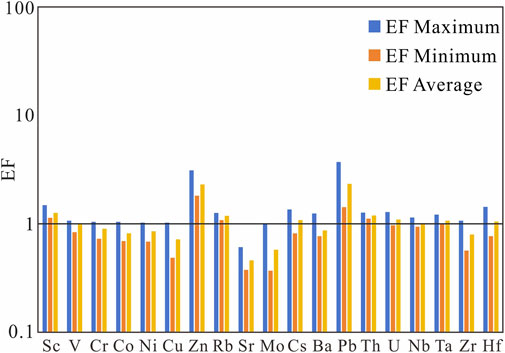
Figure 4. Trace element enrichment factors (EF) of the Bagong Formation mudstones from the Tielong section, Eastern Qiangtang Basin.
The results and related parameters for the rare earth elements (REEs) in the Bagong Formation mudstones in the Tielong Section are listed in Supplementary Table S4. The results show that the total REE contents in the Bagong Formation mudstone samples in the study area greatly fluctuate and range from 177.3 to 234.7 ppm (average of 212.0 ppm), with the majority of samples having ∑REE contents higher than the PAAS content (185 ppm; Taylor and McLennan, 1991). A significant positive correlation is observed between the ∑REE content and the Al2O3 content of the samples in the study area (R = 0.85; n = 31; Supplementary Table S2); these results indicate that the enrichment of REEs is associated mainly with the input of terrigenous detritus. In addition, the contents of light REEs (LREEs) (156.3–212.4 ppm) in the Bagong Formation mudstone samples from the study area are significantly greater than those of heavy REEs (HREEs) (20.3–24.8 ppm), and the LREE/HREE ratios range from 7.48 to 9.58 (Supplementary Table S4); these results clearly distinguish LREEs and HREEs. The chondrite- and PAAS-normalized REE distribution curves of the Bagong Formation mudstone samples in the study area are shown in Figure 5. All the samples exhibit similar REE distribution curves. After PAAS normalization, the (La/Yb)N ratios of almost all the samples are close to 1.0 and range from 0.88 to 1.15, with an average of 0.98 (Supplementary Table S4); these results indicate weak differentiation between the LREEs and HREEs in the Bagong Formation mudstones. In addition, almost all mudstone samples show slight positive Eu anomalies, with Eu anomaly (δEu) values ranging from 0.99 to 1.10 (avg. of 1.04), and weak negative Ce anomalies, with Ce anomaly (δCe) values ranging from 0.84 to 0.96 (avg. of 0.87) (Supplementary Table S4). However, the Bagong Formation mudstone samples after chondrite normalization all exhibit significant negative Eu anomalies (δEu = 0.63–0.70; avg. of 0.66; Supplementary Table S4) and weak negative Ce anomalies (δCe = 0.85-0.95; avg. of 0.87; Supplementary Table S4).
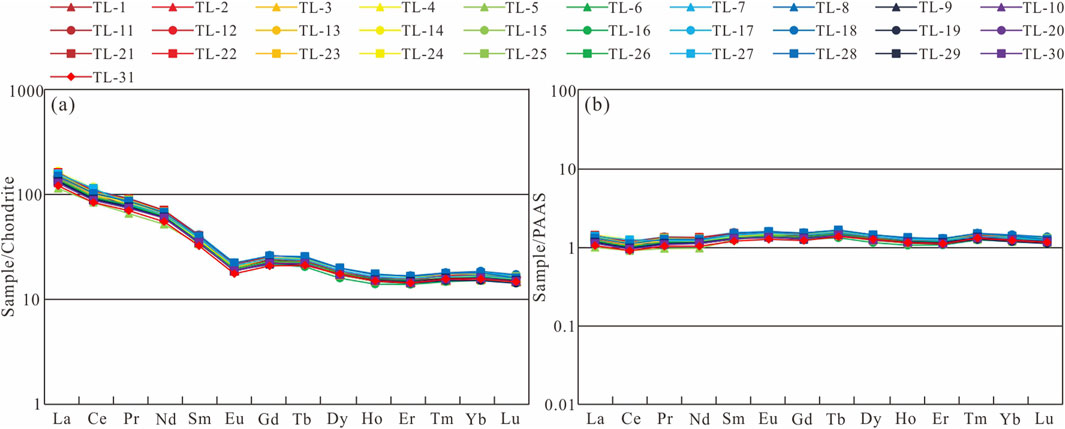
Figure 5. The chondrite (a) and post-Archaean Australian shale (b) normalized rare earth element distribution diagrams of the Bagong Formation mudstones from the Tielong section, Eastern Qiangtang Basin.
5 Discussion
5.1 Provenance and tectonic setting of the Bagong Formation mudstones
5.1.1 Provenance
Owing to the stability of certain trace elements (such as Cr, Th, Co, Zr, Sc, and Hf) in clastic rocks, their contents in clastic rocks are similar to those in their parent rocks and are thus often used for provenance tracing (Armstrong-Altrin et al., 2004; Tao et al., 2014; Moradi et al., 2016). In general, La, Th, and Hf tend to occur in felsic rocks and their weathering products, whereas Co, Sc, and Cr are more likely to occur in mafic rocks and their weathering products (Armstrong-Altrin et al., 2004; Cheng et al., 2024). The La/Th–Hf (Floyd and Leveridge, 1987), Cr/Th–Sc/Th (Condie and Wronkiewicz, 1990) and Co/Th–La/Sc (Condie, 1993) diagrams are widely used in the identification of clastic provenances. In the La/Th–Hf diagram, the mudstones of the Bagong Formation in the Tielong Section present low and clustered La/Th ratios and high Hf contents, ranging from 2.61 to 3.22 and 3.73–6.53 ppm, respectively (Supplementary Table S3), and most samples plot within the felsic provenance field, except two samples that plot into the mixed mafic and acidic provenance field (Figure 6a). In the Co/Th–La/Sc diagram, the mudstone samples from the Bagong Formation in the Tielong Section have low Co/Th and La/Sc ratios overall, ranging from 0.90 to 1.39 (avg. of 1.08) and 2.05–2.81 (avg. of 2.49) (Supplementary Table S3), respectively, and all plot between monzogranite and granodiorite, indicating a primarily felsic provenance (Figure 6b). In the Cr/Th–Sc/Th diagram, the Bagong Formation mudstones in the study area also have low Cr/Th and Sc/Th ratios, ranging from 4.75 to 6.73 and 1.05–1.41, respectively, and all plot between those of monzogranite and granodiorite and indicate a primarily felsic provenance (Figure 6c). In addition, in the Th/Sc–Zr/Sc cross-plot (Figure 6d), the Bagong Formation mudstone samples in the study area are all located along the trend line indicating compositional variation (near the granite end-members) and are far from the trend line indicating sedimentary cycling; these results indicate that the sediments did not undergo significant sedimentary recycling during deposition and are characterized by a felsic provenance.
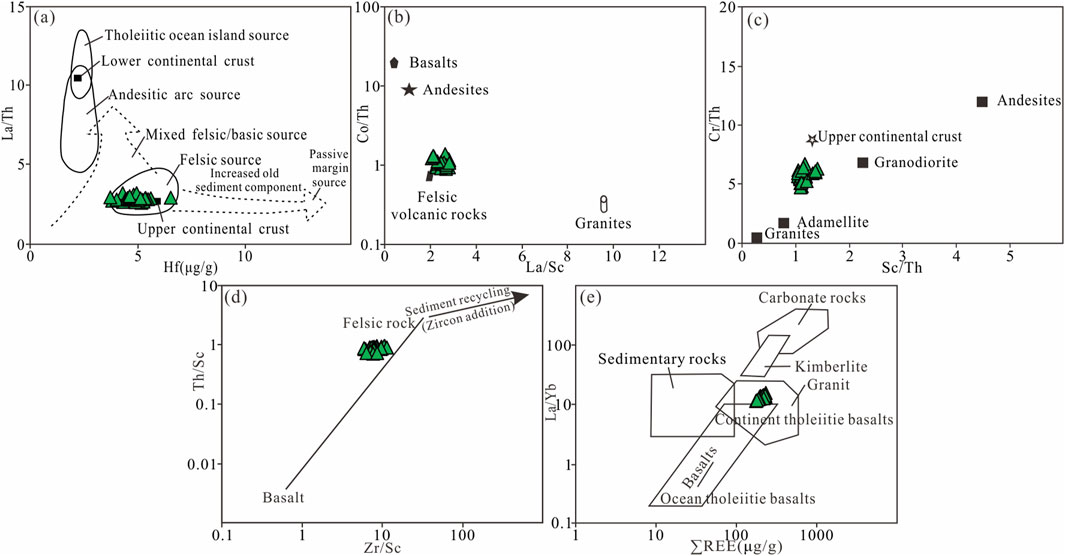
Figure 6. Provenance discrimination diagrams for the Bagong Formation mudstones from the Tielong section, Eastern Qiangtang Basin. (a) La/Th-Hf; (b) Co/Th-La/Sc; (c) Cr/Th-Sc/Th; (d) Th/Sc-Zr/Sc; (e) La/Yb-∑REE.
Considering their stable geochemical properties, REEs are also widely used in sediment source tracing (Moradi et al., 2016; Wang et al., 2018; Casas-Peña et al., 2021). In general, felsic source rocks tend to have high LREE/HREE ratios and significant negative Eu anomalies, whereas mafic source rocks often have low LREE/HREE ratios and no evident negative Eu anomalies (Roddaz et al., 2006; Wang et al., 2017). However, the δEu values of clastic sedimentary rocks can also be affected by diagenesis and are thus significantly positively correlated with δCe and ∑REE (Shields and Stille, 2001). As mentioned earlier, the δEu values of the Xiali Formation clastic rock samples in the study area are not significantly correlated with the δCe and ∑REE values (Supplementary Table S2); these results indicate that the δEu values of the clastic rock samples are basically unaffected by diagenesis but are inherited from the source rocks. In this study, after chondrite normalization, the REEs of the Bagong Formation mudstones exhibit a significant negative Eu anomaly (Figure 5a), with δEu values ranging from 0.67 to 0.75 (avg. of 0.70; Supplementary Table S4); thus, they originate mainly from a felsic source. In addition, the La/Yb–∑REE diagram proposed by Allègre and Minster, (1978) can be used to effectively distinguish the properties of four types of source rocks: sedimentary rocks, granite, alkaline basalt and tholeiite. In this diagram, all the samples plot within the granite region, indicating that their parent rocks are mainly acidic rocks, such as granite (Figure 6e).
5.1.2 Tectonic setting
The tectonic setting of sediments largely depends on the chemical composition of clastic rocks because clastic rocks that form in different tectonic environments have different chemical compositions (Roser and Korsch, 1988; Bhatia and Crook, 1986; Armstrong-Altrin and Verma, 2005). To define the tectonic setting of sediments, many traditional discriminant diagrams, such as K2O/Na2O–SiO2, Th–Co–Zr/10, and La‒Th‒Sc diagrams, have been proposed to distinguish tectonic settings and include passive continental margins, active continental margins, continental island arcs and oceanic island arcs (Roser and Korsch, 1988; Bhatia and Crook, 1986). However, these traditional discriminant diagrams have a low success rate in determining tectonic settings and have been used with caution in recent years (Armstrong-Altrin and Verma, 2005; Verma and Armstrong-Altrin, 2013).
Recently, Verma and Armstrong-Altrin (2013) applied statistical principles to propose two multidimensional discriminant diagrams based on the main oxides of Cenozoic sediments, and these oxides can effectively be used to differentiate three different tectonic settings (collision, rift and island arc) during the period of clastic rock deposition; thus, these diagrams are widely used (Moradi et al., 2016; Deng et al., 2019). In the discriminant diagrams, these sediments are further classified into high-silica (SiO2)adj = 63–95% and low-silica (SiO2)adj = 35–63% types, where the subscript “adj” indicates the value that corresponds to oxides being comprehensively adjusted to 100% (ignoring the loss-on-ignition value). For more details, refer to Verma and Armstrong-Altrin (2013). To define the tectonic setting of the Bagong Formation mudstones in the study area more precisely, the two multidimensional discriminant diagrams described above are used instead of the traditional discriminant diagram. Among the 31 mudstone samples from the Bagong Formation in the Tielong Section, the (SiO2)adj contents range from 58.8% to 66.1% (Supplementary Table S1), with 11 samples classified as high-silica type and 20 samples classified as low-silica type. In the discriminant diagrams of the tectonic setting for high-silica and low-silica types (Figures 6b, 7b), all the Bagong Formation samples in the study area plot within or near the collision zone; these results indicate that the Bagong Formation mudstones in the Tielong Section formed in a collisional tectonic setting and are consistent with the tectonic regime of intracontinental compression in the North Qiangtang Depression in the early Late Triassic (Li et al., 2001; Wang et al., 2017; Shen et al., 2024).
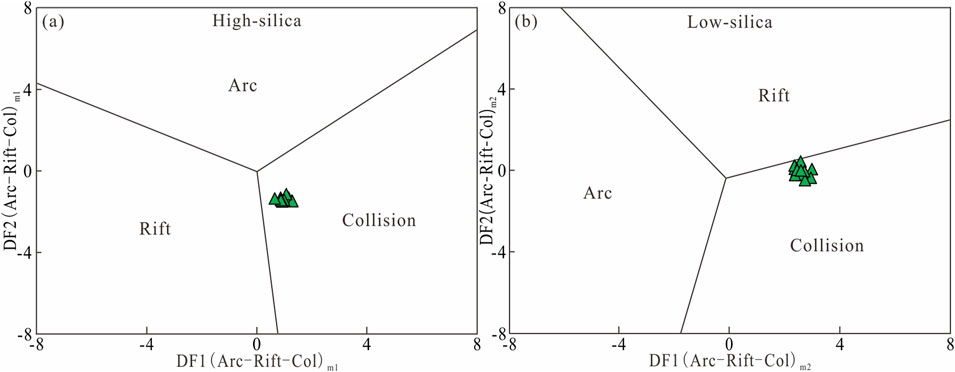
Figure 7. Multidimensional tectonic setting discrimination diagrams for the Bagong Formation clastic rocks from the Tielong section, Eastern Qiangtang Basin (Verma and Armstrong-Altrin, 2013). (a) High-silica clastic rocks; (b) Low-silica clastic rocks.
5.2 Palaeoclimate reconstruction and terrigenous clastic input of the Bagong formation mudstones during the depositional period
Palaeoclimate conditions can, on the one hand, control the process of clastic input from the provenance into the sedimentary basin and, on the other hand, influence the growth and reproduction of organisms, thus affecting the preservation and enrichment of organic matter in the sediments. The Sr/Cu ratios of trace elements in mudstone are usually used to identify palaeoclimate conditions during deposition; a Sr/Cu ratio less than 10 indicates a warm and humid climate, whereas a Sr/Cu ratio greater than 10 reflects a hot and arid climate (Lerman, 1978). In the study area, the Sr and Cu contents of the Bagong Formation mudstones in the Tielong Section are not significantly correlated with the Al2O3 content (R = −0.2 and 0.15, respectively; n = 31); these results indicate that the Sr and Cu in the samples are derived from nonclastic origins and can effectively reflect the palaeoclimate characteristics. The Sr/Cu ratios of the mudstone samples in the study area range from 2.05 to 3.50 (avg. of 2.59), and all the ratios are significantly lower than 10.0 (Figure 8); these results indicate warm and humid climate conditions during the deposition of the Bagong Formation. In addition, under a humid climate, the contents of Fe, Mn, Cr, V, Ni, and Co are high in sediments, whereas under arid conditions, evaporation leads to the relative enrichment of Ca, Mg, K, Na, Sr, and Ba. The C value, which is calculated from the ratios of these two types of elements (∑(Fe + Mn + Cr + Ni + V + Co)/∑ (Ca + Mg + Sr + Ba + K + Na)), is widely used to reconstruct the palaeoclimate conditions during the deposition of fine-grained sedimentary rocks. Studies have shown that C values <0.2, 0.2-0.4, 0.4-0.6, 0.6-0.8, and >0.8 indicate arid, semiarid, semiarid to semihumid, semihumid and humid climate conditions, respectively (Zhao et al., 2007; Cao et al., 2012). The C values of the Bagong Formation mudstone samples in the study area range from 0.65 to 0.77 (avg. of 0.71; Supplementary Table S1; Figure 8); these values range between 0.6 and 0.8 and indicate overall semihumid climate conditions in the study area. The variations in the Rb/Sr ratios of the sediments are caused by the differences in the material compositions of rock weathering products due to climate change (Li et al., 2019). High Rb/Sr values generally indicate a humid climate, and low values indicate an arid climate (Lei et al., 2024). The Rb/Sr ratios of the Bagong Formation mudstone samples in the study area are relatively high and range from 1.46 to 2.55 (avg. of 2.09; Figure 8); these results indicate warm and humid climate conditions. On the basis of the Sr/Cu–C values (Figure 9a) and the Rb/Sr–Sr/Cu diagram (Figure 9b), the climate during the deposition of the Bagong Formation mudstones was likely warm and humid overall.
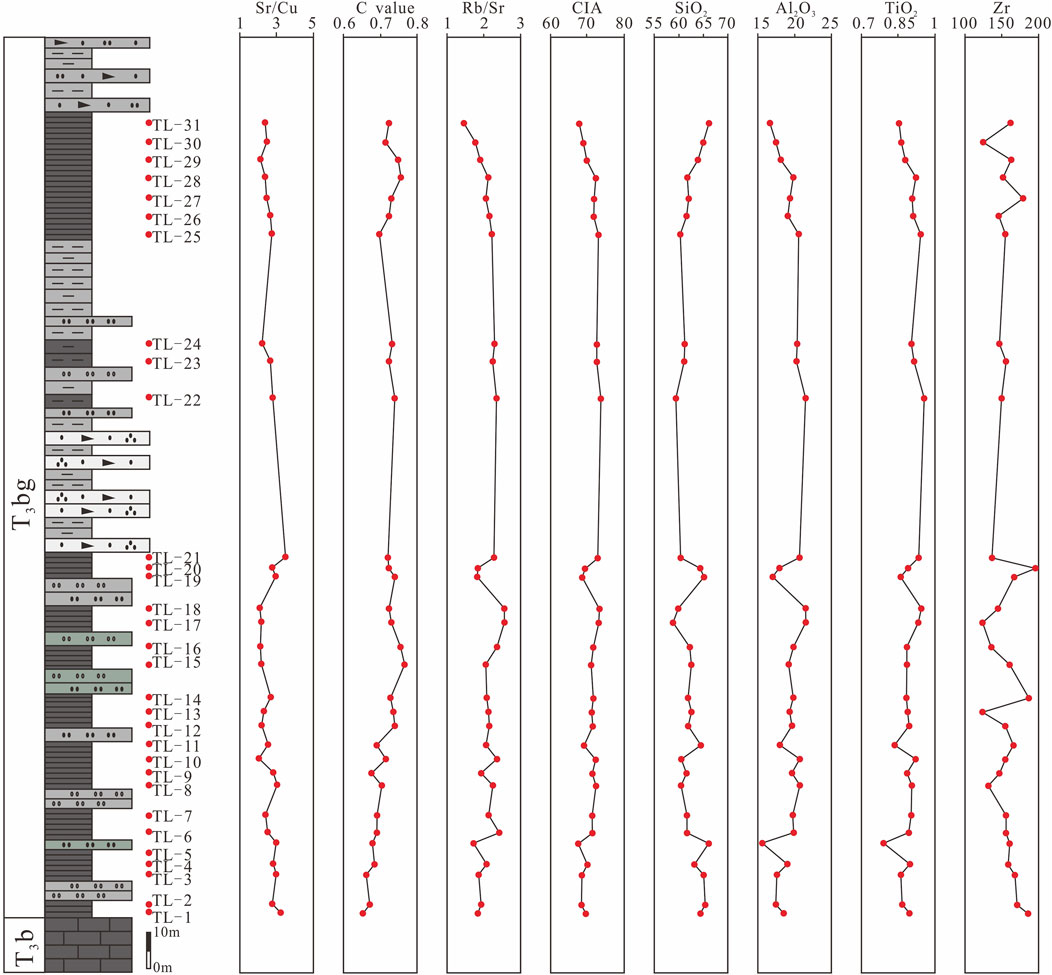
Figure 8. Vertical variation of paleoclimate and terrigenous influx of the Bagong Formation mudstones from the Tielong section, Eastern Qiangtang Basin.
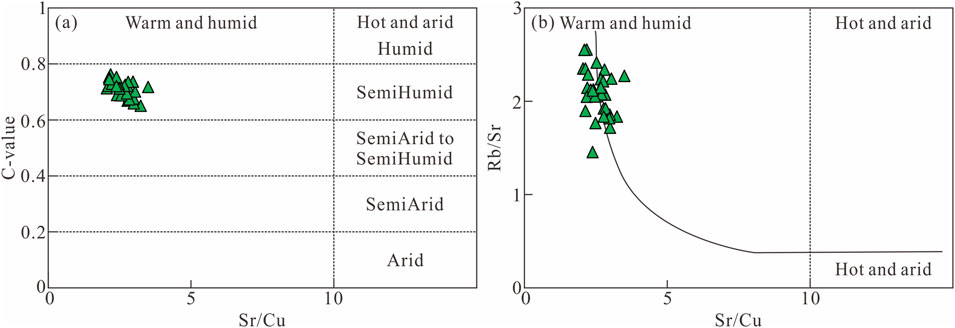
Figure 9. Discrimination diagram of paleoclimate and paleosalinity of the Bagong Formation mudstones from the Tielong section, Eastern Qiangtang Basin. (a) C-Sr/Cu, (b) Rb/Sr-Sr/Cu.
In addition, the chemical weathering intensity of the clastic rock source area is closely related to the palaeoclimate (Nesbitt and Young, 1982; Fedo et al., 1997). The chemical index of alteration (CIA), proposed by Nesbitt and Young (1982) as an important chemical weathering indicator, has been widely used in evaluating the chemical weathering intensity and reconstructing the palaeoclimate in geographical periods (Nesbitt and Young, 1982; Fedo et al., 1997; Yan et al., 2010; Hessler et al., 2017; Xu and Shao, 2018; Liu et al., 2019). Through systematic assessment of the factors influencing the chemical weathering index, Xu and Shao (2018) proposed that when the CIA is used to determine the degree of weathering of the source area, the following recommended process should be used: argillaceous rock samples need to be initially selected; the index of compositional variability (ICV) value (molar (Fe2O3+K2O + Na2O + CaO*+MgO + MnO + TiO2)/M (Al2O3)) should then be calculated on the basis of the major elements of the argillaceous rock; afterwards, the CIA (molar [Al2O3/(CaO*+Na2O + Al2O3+K2O)]×100) for samples with ICV>1 can be calculated; the CIA value needs to be corrected for potassium metasomatism using the A‒CN‒K ternary diagram; finally, the potassium-corrected CIAcorr value should be used to reflect the degree of chemical weathering in the source area. In the formulas for calculating the ICV and CIA, CaO* represents the CaO content in silicate minerals (Nesbitt and Young, 1982). In the present study, the method proposed by Taylor and Mclennan, (1991) is used to correct for the CaO*, i.e., molar CaO* = min (molar (CaO-10/3 P2O5) (Na2O)). For the mudstones in the Bagong Formation in the Tielong Section in the study area, the ICV values range from 1.75 to 2.22 (avg. of 1.92; all values greater than 1), and the CIA values are between 69.9 and 75.4 (avg. of 73.2) (Supplementary Table S1). In the A‒CN‒K ternary diagram, the mudstone samples from the Bagong Formation in the Tielong Section greatly deviate from the ideal weathering trend line and are close to the AK line (Figure 10); these results indicate a strong influence of potassium metasomatism. Therefore, potassium correction of the CIA values of the Bagong Formation mudstone samples in the study area needs to be performed. When potassium correction is performed using the A‒CN‒K ternary diagram, the first step involves observing the interval in which the sample points are located. On the basis of the distribution of these points, the ideal weathering trend line of the samples without potassium metasomatism is determined (Figure 10). A reverse extension line is then drawn from the K end-member through the sample points, and its intersection with the ideal weathering trend line of the sample represents the CIA value of the sample before potassium metasomatism (Fedo et al., 1995). The potassium-corrected CIA (CIAcorr) values of the Bagong Formation mudstone samples in the study area range from 73.3 to 83.2. Since most CIAcorr values are between 70 and 80 (Supplementary Table S1; Figure 10), the provenance area of the Tielong Section experienced moderate chemical weathering and warm and humid climate conditions; these results are generally consistent with previous results determined using Sr/Cu, Rb/Sr ratios, and C values.
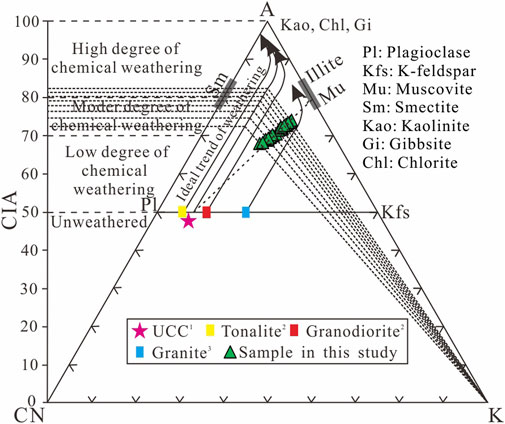
Figure 10. A-CN-K ternary diagram of the Bagong Formation mudstones from the Tielong section, Eastern Qiangtang Basin (Modify after Nesbitt and Young, 1982). A-Al2O3; CN- (CaO+Na2O); K-K2O; CIA: Chemical index of alteration.
In summary, the Bagong Formation mudstones experienced warm and humid climate conditions during deposition, and their provenance was mainly felsic rocks. The warm and humid climate promoted chemical weathering in the provenance area, which may have allowed more felsic detritus to enter the depositional area. Si, Al, Ti, and Zr usually originate from terrigenous clastic grains and are considered important indicators for evaluating clastic material input (Tribovillard et al., 2006; Lézin et al., 2013; Liu et al., 2018; Wang et al., 2022c). Among these elements, Si, Ti, and Zr in sediments are usually used as indicators of coarse-grained sedimentary input, whereas Al is generally an indicator of fine-grained sedimentary input (Canfield, 1994). The SiO2, Al2O3, TiO2, and Zr contents of the Bagong Formation mudstones in the study area are 53.8–61.3% (avg. of 57.6%), 14.5–19.8% (avg. of 17.7%), 0.73–0.88% (avg. of 0.82%), and 124–196 ppm (avg. of 156 ppm), respectively; these values are generally lower than those of PAAS (62.8%, 18.9%, 0.99%, and 210 ppm, respectively) (Figure 8). These results indicate that during the deposition of the Bagong Formation mudstones in the Tielong Section, the input of fine-grained terrigenous detritus was greater than that of coarse-grained detritus.
5.3 Reconstruction of the palaeoenvironment of the Bagong formation mudstones during the depositional period
5.3.1 Palaeo-redox conditions
The redox conditions of the water column can affect the decomposition and preservation of organic matter (Demaison and Moore, 1980; Tyson and Pearson, 1991). Trace elements, such as V, U, Mo, and Cr, are sensitive to the redox conditions of the water column, and their EFs and element ratios, such as VEF, UEF, MoEF, V/Cr, Ni/Co, and U/Th, are often used to reconstruct the redox level of the water column (Algeo and Maynard, 2004; Tribovillard et al., 2006; Li et al., 2015; Wang et al., 2022c). Tribovillard et al. (2006) proposed that in marine systems, V, U, and Mo are usually enriched under anoxic conditions and have high EF values. This understanding has since been widely applied in lacustrine, transitional and carbonate depositional environments (Kara-Gülbay and Korkmaz, 2008; Cao et al., 2018). The EF values of U in the Bagong Formation mudstones in the Tielong Section range from 0.97 to 1.28 (Supplementary Table S3; Figure 11), and only one sample has an EF value slightly greater than 1; thus, these results indicate weak depletion. The EF values of Mo are in the range of 0.37–0.99 (Supplementary Table S3; Figure 11); these results generally correlate with significant depletion. Under anoxic‒sulfidic conditions, in the chemocline of the marine water column, Mo can be deposited in large quantities on the sediment surface, whereas when U is deposited on the sediment surface near the chemocline, U partially dissipates, resulting in UEF < MoEF. Under suboxic conditions, owing to the absence of H2S in the water column, the redox interface of Fe appears near the sediment interface, whereas the chemocline is below the sediment‒seawater interface; this process results in minimal Mo deposition and substantial U deposition on the sediment surface, leading to UEF > MoEF. Under oxidizing conditions, the contents of U and Mo in the sediments are both low (Zhang et al., 2017). In the UEF–MoEF cross-plot (Figure 12a), the Bagong Formation mudstone samples in the study area all plot within 0.three to one times the value of seawater (SW); thus, the sedimentary water column was in an oxidizing environment.

Figure 11. Vertical variation of paleoredox condition (UEF, MoEF, U/Th, V/Cr, Ni/Co, Corg/Ptot and δCe), paleobathymetry (Mn/Fe), paleosalinity (Sr/Ba and Rb/K), and sedimentary rate ((La/Yb)N) of the Bagong Formation mudstones from the Tielong section, Eastern Qiangtang Basin.
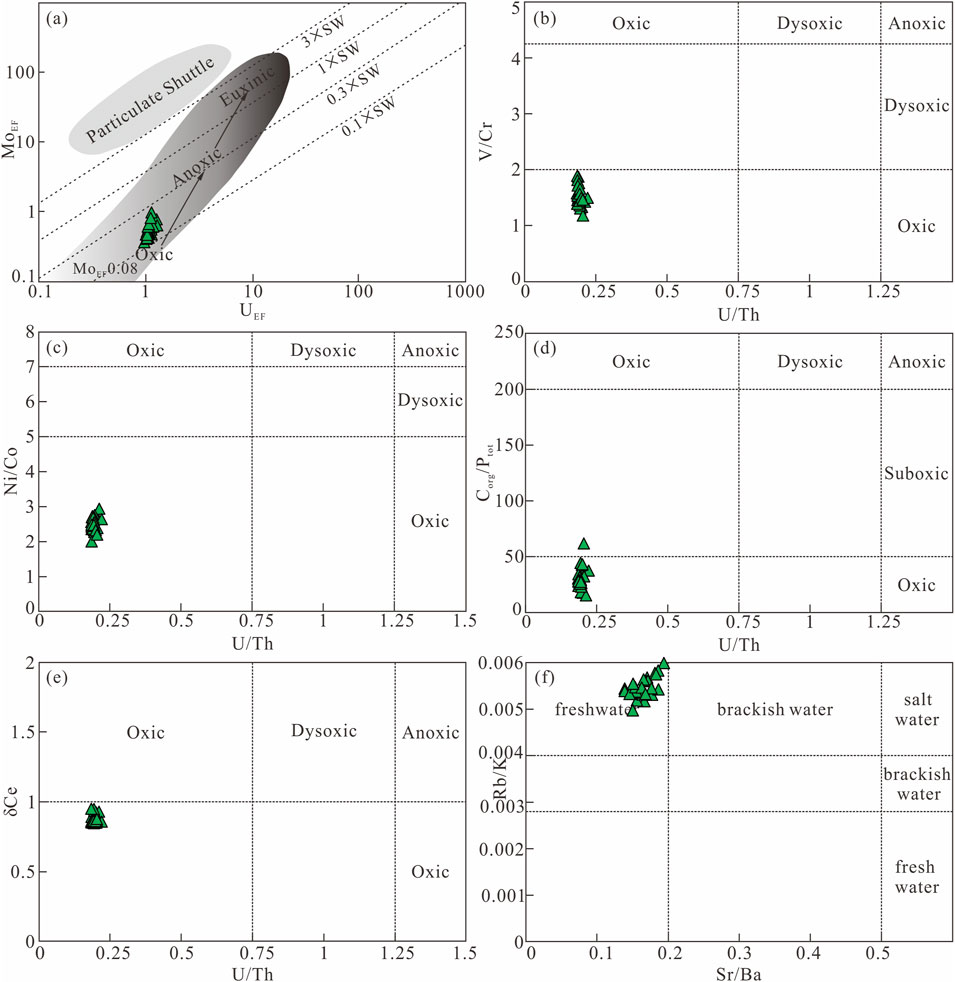
Figure 12. Discrimination diagram for redox conditions and paleosalinity of the Bagong Formation mudstones from the Tielong section, Eastern Qiangtang Basin. (a) UEF-MoEF; (b) V/Cr-U/Th; (c) Ni/Co-U/Th; (d) Corg/Ptot-U/Th; (e) δCe-U/Th; (d) Sr/Ba-Rb/K.
In terms of trace element ratios, U/Th, V/Cr and Ni/Co all decrease with increasing degrees of oxidation in the benthic water column. U/Th < 0.75, V/Cr < 2, and Ni/Co < 5 indicate an oxidizing environment; U/Th values in the ranges of 0.75–1.25, 2.0–4.25, and five to seven indicate a hypoxic environment; and U/Th > 1.25, V/Cr > 4.25, and Ni/Co > 7 reflect an anoxic environment (Jones and Manning, 1994). Significant positive correlations are observed between the V and Cr contents, between the Ni and Co contents, and between the U and Th contents (R = 0.50, 0.72, and 0.86, respectively; n = 31; Supplementary Table S2) in the Bagong Formation mudstone samples in the study area; these results indicate that these elements have the same properties and sources and that their ratios can effectively reflect the redox conditions of the water column. The U/Th, V/Cr, and Ni/Co ratios of the Bagong Formation mudstones in the Tielong Section range from 0.18–0.22 (avg. of 0.19), 1.18–1.89 (avg. of 1.53), and 2.00–2.94 (avg. of 2.52) (Supplementary Table S3), respectively; the three parameters are all less than the threshold values under oxidizing conditions and indicate an oxidizing environment (Figure 11). In addition, Algeo and Ingall (2007) proposed that the organic carbon (Corg)/total phosphorous (Ptot) ratio is closely related to the redox conditions in marine sediments; this ratio has been widely used in recent years (Algeo and Ingall, 2007; Shen et al., 2015; Wang et al., 2017; 2022c). In general, low Corg/Ptot values (<50) reflect oxidizing conditions, moderate Corg/Ptot values (50–200) indicate suboxic conditions, and high Corg/Ptot values (>200)reflects anoxic reducing conditions (Algeo and Ingall, 2007; Shen et al., 2015). The Corg/Ptot values of the mudstones in the study area range from 15 to 62 (avg. of 30; Supplementary Table S1), with one value slightly higher than 50 and the remaining values all lower than 50; these results indicate overall oxidizing conditions. On the basis of the V/Cr‒U/Th (Figure 12b), Ni/Co‒U/Th (Figure 12c), and Corg/Ptot‒U/Th (Figure 12d) discriminant diagrams, the Bagong Formation mudstones in the Tielong Section experienced an oxidizing water column during the depositional period.
In addition, Ce anomalies in sediments are usually considered important indicators for reconstructing palaeoredox conditions (Alibo and Nozaki, 1999; Yan et al., 2009; Hu et al., 2019). Under oxidizing conditions, Ce3+ is usually oxidized to Ce4+; this reaction occurs in sediments in the form of CeO2 (Alibo and Nozaki, 1999). In contrast, Ce4+ is often reduced to soluble Ce3+ in anoxic water columns (Alibo and Nozaki, 1999). Therefore, negative Ce abnormalities usually indicate an oxidizing environment, whereas positive Ce abnormalities reflect a hypoxic‒anoxic environment. The Ce anomaly values (δCe = 2*CeN/(LaN + PrN)) of the Bagong Formation mudstones in the study area range from 0.84 to 0.96 (avg. of 0.87; Supplementary Table S4; Figure 11) and show a weak negative Ce anomaly; these results indicate an oxidizing environment during the depositional period of the Bagong Formation in the Tielong Section (Figure 12e).
5.3.2 Palaeo-water depth and palaeosalinity
In large palaeolakes and oceans, the enrichment of Mn and Fe is significantly correlated with water depth and distance from the shore. Owing to its unstable geochemical properties, Fe is enriched mainly in shallow-water areas near the shore, whereas Mn can be transported over long distances and enriched in deep water far from the shore because of its stable geochemical properties (Li et al., 2017; Lei et al., 2024). Therefore, the Mn and Fe contents and the Mn/Fe ratio can be used as proxy indicators for determining the palaeowater depth. The Mn and Fe contents of the Bagong Formation mudstones in the Tielong Section range from 465–790 ppm (avg. of 613 ppm) and 40,670–49630 ppm (avg. of 45,866 ppm) (Supplementary Table S1), respectively; these values are lower than those of the PAAS (852 and 50,260 ppm, respectively). The Mn/Fe ratios of the Bagong Formation mudstones in the study area range from 0.01 to 0.018 (avg. of 0.013; Supplementary Table S1); these values are generally lower than those of the PAAS (0.016). These results indicate that the water column of the Bagong Formation mudstones in the study area was shallow during the depositional period and was consistent with the oxidizing environment discussed above.
Palaeosalinity is an important aspect of the study of sedimentary palaeoenvironments and a key factor in the preservation of organic matter. The Ba and Sr contents exhibit different geochemical behaviours in nature. In marine systems, Sr can stably exist in dissolved form in the water column for a long time (approximately 2.4 Ma; Krabbenhoft et al., 2010), whereas Ba2+ readily combines with SO42- to form BaSO4 precipitates (Tribovillard et al., 2006). In general, the Sr content in seawater is significantly greater than the Ba content, whereas the Ba content in fresh water is greater than the Sr content. Therefore, the Sr/Ba ratio in fine-grained sedimentary rocks is widely used to reconstruct the palaeosalinity of the water column (Meng et al., 2012; Wei and Algeo, 2020; Wang et al., 2022c). In the study area, the Bagong Formation mudstone samples from the Tielong Section have low CaO contents, and no correlation is observed between the CaO and Sr contents (R = 0.16; n = 31); these results indicate that the Sr content is not affected by carbonate minerals. Recently, Wei and Algeo (2020) conducted a statistical analysis and proposed that the optimal thresholds of Sr/Ba in freshwater and saltwater are 0.2 and 0.5 (Remírez and Algeo, 2020), respectively. Specifically, Sr/Ba ratios <0.2 indicate a freshwater environment, values of 0.2–0.5 represent a brackish environment, and values > 0.5 reflect a saline environment. The Sr/Ba ratios of 31 mudstone samples from the Bagong Formation in the study area range from 0.14 to 0.19 (avg. of 0.16; Supplementary Table S3), indicating a freshwater environment during their deposition. However, a significant positive correlation is observed between the Ba content (excluding sample TL-31) and the Al2O3 content of the Bagong Formation mudstone samples (R = 0.88, n = 30; Supplementary Table S2); these results indicate that the Ba content in the samples is derived mainly from terrigenous detrital input, resulting in a low Sr/Ba ratio in the samples. Therefore, the mudstones in this study may have formed in a brackish to saline environment.
Rb/K is another important indicator for reconstructing palaeosalinity. Generally, Rb/K < 0.0028 indicates a freshwater environment, 0.0028<Rb/K < 0.004 indicates a brackish environment, and Rb/K > 0.004 indicates a saline environment (Zhang et al., 2024). In the study area, a significant positive correlation is observed between the Rb and K contents of the Bagong Formation mudstone samples from the Tielong Section (R = 0.96, n = 31; Supplementary Table S2); thus, they have the same properties and sources, and their ratios can effectively reflect the salinity of the water column. The Rb/K values of the 31 mudstone samples from the Bagong Formation in the study area range from 0.005 to 0.006 (avg. 0.0055; Supplementary Table S3); these results indicate that the Bagong Formation mudstones formed in a saline environment (Figure 11). On the basis of the Sr/Ba‒Rb/K discriminant diagram, the Bagong Formation mudstones in the Tielong Section were deposited in a saline environment (Figure 12f).
5.4 Genetic mechanism of the black mudstones in the Bagong formation
The mudstones of the Upper Triassic Bagong Formation in the Tielong Section in the eastern North Qiangtang Depression exhibit large fluctuations in TOC contents (0.47%–1.73%, avg. of 0.87%), with vertically differentiated organic matter enrichment. Research has shown that organic matter enrichment in mudstones is a complex process involving the interaction of multiple factors, including the palaeoproductivity of the surface water column, redox degree of the bottom water column, salinity stratification, sedimentation rate, and detrital input (Canfield, 1994; Sageman et al., 2003; Katz, 2005; Wei et al., 2012; Wang et al., 2017). However, the factors controlling organic matter enrichment vary under different depositional settings; thus, the organic matter enrichment process is a subject of ongoing debate.
The palaeoclimate largely affects the chemical weathering of rocks and the growth and reproduction of organic matter in the provenance area (Carroll and Bohacs, 1999; Meng et al., 2012; Ma et al., 2015) and thus controls the organic matter content in the mudstone sedimentation process. Palaeoclimate indicators (C value, Sr/Cu and Rb/Sr ratios, and CIA) reveal that the palaeoclimate during the deposition of the Bagong Formation mudstones in the Tielong Section was generally warm and humid. The TOC contents of almost all the Bagong Formation mudstone samples in the study area are significantly negatively correlated with the palaeoclimate indicator of Sr/Cu (R = −0.63, n = 29; Figure 13a) and significantly positively correlated with Rb/Sr (R = 0.66, n = 24; Figure 13b), the C value (R = 0.71, n = 30; Figure 13c), and the CIA (R = 0.75, n = 24; Figure 13d); these results indicate that organic matter enrichment was mainly controlled by warm and humid climate condition and that these conditions were conducive to the growth and reproduction of organisms and thus promoted the enrichment of organic matter. Additionally, in a warm and humid climate, owing to the input of a large amount of fine-grained argillaceous detritus (the Al content is high) and a small amount of coarse-grained felsic terrigenous detritus (the contents of Si, Ti, and Zr are low), overall, the depositional period of the Bagong Formation mudstones occurred because the adsorption rate of the organic matter by argillaceous detritus exceeded the dilution rate of organic matter by felsic detritus, and the large specific surface area of clay minerals enhanced their ability to protect organic matter (Li et al., 2025); this reasoning is supported by the significant positive correlation between the TOC content and the Al2O3 content (R = 0.67, n = 24; Figure 13e) and the significant negative correlation between the TOC content and the SiO2 content (R = −0.68, n = 24; Figure 13f) in most mudstone samples.
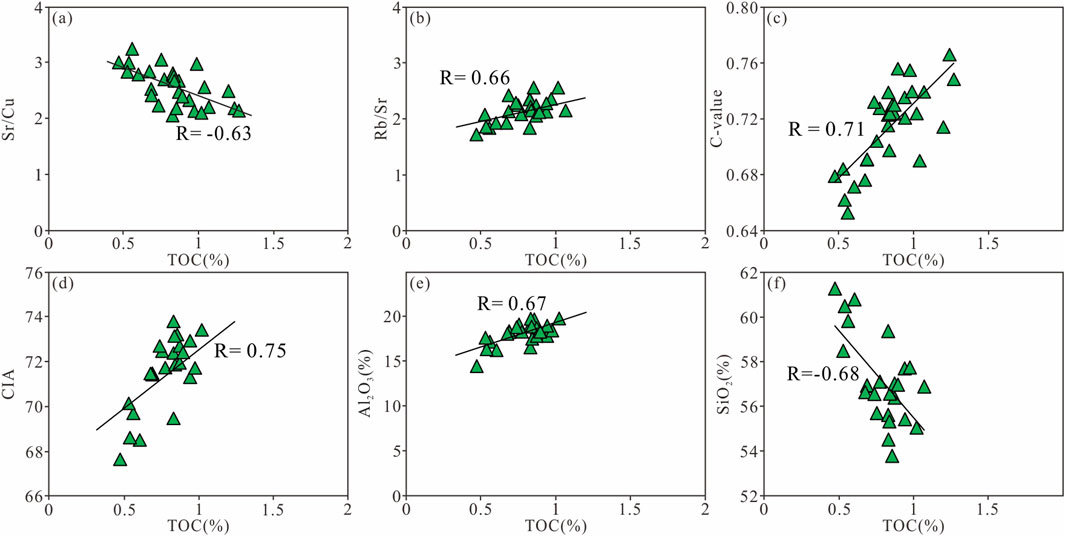
Figure 13. Relationship between TOC content and paleoclimate (C value, Sr/Cu, Rb/Sr ratios and CIA value) and terrigenous influx (Al2O3) of the Bagong Formation mudstones from the Tielong section, Eastern Qiangtang Basin.
In addition, redox conditions and sedimentation rates are important factors controlling the preservation of organic matter. A comprehensive analysis of multiple redox indicators (UEF‒MoEF, U/Th, V/Cr, Ni/Co, Corg/Ptot, and δCe) reveals that the Bagong Formation mudstones in the study area were deposited in an oxidizing environment. However, a fast sedimentation rate in an oxidizing environment is usually beneficial for the preservation of partly organic matter since it effectively shortens the contact time between the organic matter and oxygen, accelerates the accumulation of organic matter, and consequently enables the rapid burial and preservation of partly organic matter (Tyson, 2001; Ding et al., 2015; Wang et al., 2017; Li et al., 2025). The sedimentation rate can be characterized by the (La/Yb)N (the subscript N indicates PAAS-normalized) value of the REEs; here, a value significantly greater than or less than one indicates a slow sedimentation rate, and a value close to 1.0 indicates a fast sedimentation rate (Tenger et al., 2006). The (La/Yb)N values of the 31 mudstone samples from the Bagong Formation in the study area range from 0.85 to 1.15 (avg. of 0.98; Supplementary Table S4) and are predominantly concentrated at approximately 1.0 for most samples (Figure 11); these results indicate an overall high sedimentation rate of the Bagong Formation mudstones in the Tielong Section during the depositional period. The high sedimentation rate in an oxidizing water column caused the burial rate of the organic matter to exceed its degradation rate. Several organic matter was degraded by aerobic bacteria during the burial process, and consequently only a portion of the organic matter was preserved.
In summary, the warm and humid palaeoclimate and rapid sedimentation rate were the main factors controlling the enrichment of organic matter in the Upper Triassic Bagong Formation mudstones in the Tielong Section. On the one hand, warm and humid palaeoclimate conditions promoted the proliferation of organisms, enhancing the palaeoproductivity of the water column; on the other hand, compared with the diluting effect of coarse-grained felsic terrigenous detritus, the input of fine-grained clayey terrigenous detritus resulted in a stronger adsorption effect on organic matter and led to the preservation of partly organic matter. In addition, although the oxidizing environment led to the degradation of most organic matter, a small amount of organic matter was buried due to rapid sedimentation. As a result, overall, the Bagong Formation mudstones in the Tielong Section had relatively low organic carbon contents during their depositional period (Figure 14).
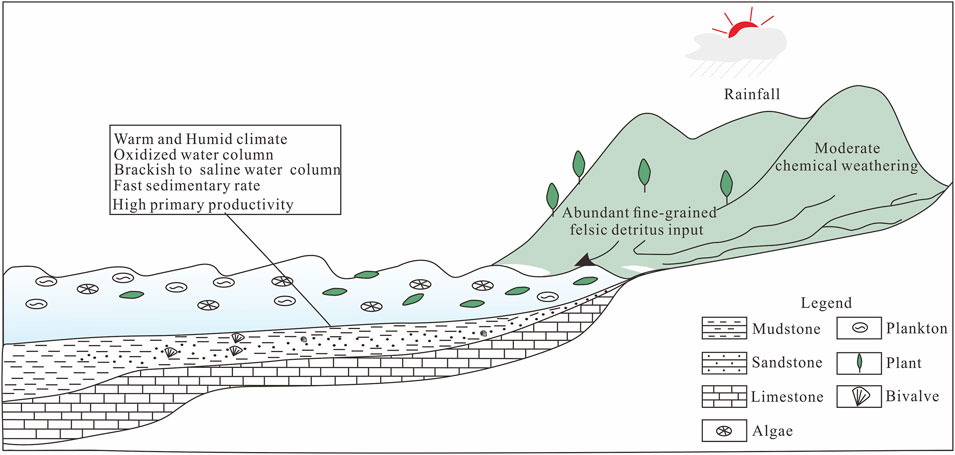
Figure 14. Sketch of a sedimentary model for the Bagong Formation mudstones from the Tielong section, Eastern Qiangtang Basin (modified after Yu et al., 2019).
6 Conclusion
(1) The comprehensive analysis of the La/Th‒Hf, Co/Th‒La/Sc, Cr/Th‒Sc/Th, Th/Sc‒Zr/Sc, A‒CN‒K and La/Yb‒ΣREE discriminant diagrams and the presence of significant negative Eu anomalies indicate that the provenance of the Bagong Formation in the Tielong Section in the eastern North Qiangtang Depression was mainly felsic rocks. The multidimensional discriminant diagram of the tectonic setting established using the major elements revealed that the Bagong Formation mudstones in the Tielong Section were all deposited in a collisional tectonic setting; this result was consistent with the tectonic regime of the early Late Triassic intracontinental compression in the North Qiangtang Depression.
(2) On the basis of multiple palaeoclimate indicators (C value, Sr/Cu and Rb/Sr ratios, and CIA), the depositional period of the Bagong Formation mudstones in the Tielong Section was generally characterized by a warm and humid climate, with a large amount of fine-grained detritus (with a high Al content) and a small amount of coarse-grained felsic terrigenous detritus (with low Si, Ti, and Zr contents).
(3) On the basis of the comprehensive analysis of the UEF‒MoEF cross-plots, the U/Th, V/Cr, Ni/Co, and Corg/Ptot ratios and negative Ce anomalies indicate that the Bagong Formation mudstones in the Tielong Section were deposited in an oxidizing environment; additionally, the low Mn/Fe ratio and relatively high Rb/K ratio indicate that the Bagong Formation mudstones in the study area were deposited in a shallow saline environment.
(4) A warm and humid palaeoclimate and a rapid sedimentation rate were the main factors controlling organic matter enrichment in the Upper Triassic Bagong Formation mudstones in the Tielong Section. The warm and humid palaeoclimatic conditions promoted the massive proliferation of organisms and the input of fine-grained clayey terrigenous detritus, which led to the adsorption and preservation of partly organic matter. Moreover, a small amount of organic matter was buried in the oxidizing environment because of rapid sedimentation. Since most of the organic matter was degraded during the above processes, the Bagong Formation mudstones in the study area generally have low organic carbon contents.
Data availability statement
The original contributions presented in the study are included in the article/Supplementary Material, further inquiries can be directed to the corresponding author.
Author contributions
QP: Writing – review and editing, Writing – original draft, Investigation, Resources, Data curation. BD: Data curation, Investigation, Writing – review and editing, Resources. JP: Writing – review and editing, Writing – original draft. ZL: Investigation, Software, Resources, Writing – review and editing. PD: Investigation, Resources, Writing – review and editing.
Funding
The author(s) declare that financial support was received for the research and/or publication of this article. This research was sustained by the Science and Technology Program Project of Tibet (No. XZ202501ZY0063).
Conflict of interest
The authors declare that the research was conducted in the absence of any commercial or financial relationships that could be construed as a potential conflict of interest.
Generative AI statement
The author(s) declare that no Generative AI was used in the creation of this manuscript.
Publisher’s note
All claims expressed in this article are solely those of the authors and do not necessarily represent those of their affiliated organizations, or those of the publisher, the editors and the reviewers. Any product that may be evaluated in this article, or claim that may be made by its manufacturer, is not guaranteed or endorsed by the publisher.
Supplementary material
The Supplementary Material for this article can be found online at: https://www.frontiersin.org/articles/10.3389/feart.2025.1596376/full#supplementary-material
References
Algeo, T. J., and Ingall, E. (2007). Sedimentary Corg: P ratios, paleocean ventilation, and Phanerozoic atmospheric pO2. Palaeogeogr. Palaeoclimatol. Palaeoecol. 256, 130–155. doi:10.1016/j.palaeo.2007.02.029
Algeo, T. J., and Maynard, J. B. (2004). Trace-element behavior and redox facies in core shales of Upper Pennsylvanian Kansas-type cyclothems. Chem. Geol. 206 (3), 289–318. doi:10.1016/j.chemgeo.2003.12.009
Algeo, T. J., and Tribovillard, N. (2009). Environmental analysis of paleoceanographic systems based on molybdenum-uranium covariation. Chem. Geol. 268 (3-4), 211–225. doi:10.1016/j.chemgeo.2009.09.001
Alibo, D. S., and Nozaki, Y. (1999). Rare earth elements in seawater: particle association, shale-normalization, and Ce oxidation. Geochimica Cosmochimica Acta 63 (3), 363–372. doi:10.1016/S0016-7037(98)00279-8
Allègre, C. J., and Minster, J. F. (1978). Quantitative models of trace element behavior in magmatic processes. Earth Planet. Sci. Lett. 38 (1), 1–25. doi:10.1016/0012-821X(78)90123-1
Armstrong-Altrin, J. S., Lee, Y. I., Verma, S. P., and Ramasamy, S. (2004). Geochemistry of sandstones from the upper miocene Kudankulam formation, southern India: implications for provenance, weathering, and tectonic setting. J. Sediment. Res. 74 (2), 285–297. doi:10.1306/082803740285
Armstrong-Altrin, J. S., and Verma, S. P. (2005). Critical evaluation of six tectonic setting discrimination diagrams using geochemical data of Neogene sediments from known tectonic settings. Sediment. Geol. 177 (1), 115–129. doi:10.1016/j.sedgeo.2005.02.004
Bhatia, M. R., and Crook, K. A. W. (1986). Trace element characteristics of graywackes and tectonic setting discrimination of sedimentary basins. Contributions Mineralogy Petrology 92, 181–193. doi:10.1007/BF00375292
Canfield, D. E. (1994). Factors influencing organic carbon preservation in marine sediments. Chem. Geol. 114 (3), 315–329. doi:10.1016/0009-2541(94)90061-2
Cao, J., Wu, M., Chen, Y., Hu, K., Bian, L. Z., Wang, L. G., et al. (2012). Trace and rare earth element geochemistry of Jurassic mudstones in the northern Qaidam Basin, northwest China. Chem. ErdeGeochemistry 72, 245–252. doi:10.1016/j.chemer.2011.12.002
Cao, J., Yang, R. F., Yin, W., Hu, G., Bian, L. Z., and Fu, X. G. (2018). Mechanism of organic matter accumulation in residual bay environments: the early Cretaceous Qiangtang basin, Tibet. Energy Fuels 32 (2), 1024–1037. doi:10.1021/acs.energyfuels.7b02248
Carroll, A. R., and Bohacs, K. M. (1999). Stratigraphic classification of ancient lakes: balancing tectonic and climatic controls. Geology 27 (2), 99–102. doi:10.1130/0091-7613(1999)027<0099:scoalb>2.3.co;2
Casas-Peña, J. M., Ramírez-Fernández, J. A., Velasco-Tapia, F., Alemán-Gallardo, E. A., Augustsson, C., Weber, B., et al. (2021). Provenance and tectonic setting of the paleozoic tamatán group, NE Mexico: implications for the closure of the rheic ocean. Gondwana Res. 91, 205–230. doi:10.1016/j.gr.2020.12.012
Cheng, J. X., Deng, M., Yang, G. L., and Yu, Q. (2024). Analysis of geochemical characteristics, provenance, and tectonic background of black shale in the Silurian Longmaxi Formation of the Mingsheng section in the Yanyuan area, Sichuan Province. Sediment. Geol. Tethyan Geol. 44 (04), 840–853. doi:10.19826/j.cnki.1009-3850.2023.12003
Condie, K. C. (1993). Chemical composition and evolution of the upper continental crust: contrasting results from surface samples and shales. Chem. Geol. 104 (1), 1–37. doi:10.1016/0009-2541(93)90140-E
Condie, K. C., and Wronkiewicz, D. J. (1990). The Cr/Th ratio in Precambrian pelites from the Kaapvaal Craton as an index of craton evolution. Earth Planet. Sci. Lett. 97 (3), 256–267. doi:10.1016/0012-821X(90)90046-Z
Demaison, D. J., and Moore, G. T. (1980). Anoxic environments and oil source bed genesis. Org. Geochem. 2 (1), 9–31. doi:10.1016/0146-6380(80)90017-0
Deng, T., Li, Y., Wang, Z., Yu, Q., Dong, S., Yan, L., et al. (2019). Geochemical characteristics and organic matter enrichment mechanism of black shale in the Upper Triassic Xujiahe Formation in the Sichuan Basin: implications for paleoweathering, provenance, and tectonic setting. Mar. Petroleum Geol. 109, 698–716. doi:10.1016/j.marpetgeo.2019.06.057
Ding, X. J., Liu, G. D., Zha, M., Huang, Z. L., Gao, C. H., Qu, J. X., et al. (2015). Relationship between sedimentation rate and organic matter abundance of source rocks: a case study of erlian basin. Nat. Gas. Geosci. 26 (06), 1076–1085. doi:10.11764/j.issn.1672-1926.2015.06.1076
Fedo, C. M., Nesbitt, H. W., and Young, G. M. (1995). Unravelling the effects of potassium metasomatism in sedimentary rocks and paleosols: implications for paleoweathering conditions and provenance. Geology 23 (10), 921–924. doi:10.1130/0091-7613(1995)023<0921:UTEOPM>2.3.CO
Fedo, C. M., Young, G. M., and Nesbitt, G. M. (1997). Paleoclimatic control on the composition of the paleoproterozoic serpent formation, huronian supergroup, Canada: a greenhouse to icehouse transition. Precambrian Res. 86 (3), 201–223. doi:10.1016/S0301-9268(97)00049-1
Floyd, P. A., and Leveridge, B. E. (1987). Tectonic environment of the Devonian Gramscatho basin, south Cornwall: framework mode and geochemical evidence from turbiditic sandstones. J. Geol. Soc. 144 (4), 531–542. doi:10.1144/gsjgs.144.4.0531
Gallego-Torres, D., Martínez-Ruiz, F., Paytan, A., Jiménez-Espejo, F. J., and Ortega-Huertas, M. (2007). Pliocene–Holocene evolution of depositional conditions in the eastern Mediterranean: role of anoxia vs. productivity at time of sapropel deposition. Palaeogeogr. Palaeoclimatol. Palaeoecol. 246 (2), 424–439. doi:10.1016/j.palaeo.2006.10.008
Hessler, A. M., Zhang, J. Y., Covault, J., and Ambrose, W. (2017). Continental weathering coupled to Paleogene climate changes in North America. Geology 45 (10), 911–914. doi:10.1130/G39245.1
Hu, G., Yang, R. F., Wang, L. C., Hu, W. X., and Cao, J. (2019). Hydrocarbon potential and depositional environment of the Lower Cretaceous black mudstones and shales in the coastal Guangdong Province, China. Mar. Petroleum Geol. 99, 92–106. (Article). doi:10.1016/j.marpetgeo.2018.10.008
Jones, B., and Manning, D. A. C. (1994). Comparison of geochemical indices used for the interpretation of palaeoredox conditions in ancient mudstones. Chem. Geol. 111 (1), 111–129. doi:10.1016/0009-2541(94)90085-X
Kara-Gülbay, R., and Korkmaz, S. (2008). Element contents and organic matter-element relationship of the tertiary oil shale deposits in northwest anatolia, Turkey. Energy and Fuels 22 (5), 3164–3173. doi:10.1021/ef8002137
Katz, B. J. (2005). Controlling factors on source rock development: a review of productivity, preservation, and sedimentation rate. Spec. Publ. 82, 7–16. doi:10.2110/pec.05.82.0007
Kaufman, A. J., and Knoll, A. H. (1995). Neoproterozoic variations in the C-isotopic composition of seawater: stratigraphic and biogeochemical implications. Precambrian Res. 73 (1), 27–49. doi:10.1016/0301-9268(94)00070-8
Krabbenhoft, A., Eisenhauer, A., Bohm, F., Vollstaedt, H., Fietzke, J., Liebetrau, V., et al. (2010). Constraining the marine strontium budget with natural strontium isotope fractionations (87Sr/86Sr*, δ88/86Sr) of carbonates, hydrothermal solutions and river waters. Geochem. Cosmochim. Acta. 74 (14), 4097–4109. doi:10.1016/j.gca.2010.04.009
Lash, G. G., and Blood, D. R. (2014). Organic matter accumulation, redox, and diagenetic history of the Marcellus Formation, southwestern Pennsylvania, Appalachian Basin. Mar. Petroleum Geol. 57, 244–263. doi:10.1016/j.marpetgeo.2014.06.001
Lei, C., Ye, J. R., Yin, S. Y., Wu, J. F., and Jing, Y. Q. (2024). Constraints of paleoclimate and paleoenvironment on organic matter enrichment in lishui sag, east China sea basin: evidence from element geochemistry of paleocene mudstones. Earth Sci. 49 (07), 2359–2372. doi:10.3799/dqkx.2023.011
Lézin, C., Andreu, B., Pellenard, P., Bouchez, J. L., Emmanuel, L., Fauré, P., et al. (2013). Geochemical disturbance and paleoenvironmental changes during the early toarcian in NW europe. Chem. Geol. 341, 1–15. doi:10.1016/j.chemgeo.2013.01.003
Li, H., Lu, J. L., Li, R. L., Wang, B. H., Xu, W., Zuo, Z. X., et al. (2017). Generation paleoenvironment and its controlling factors of lower Cretaceous lacustrine hydrocarbon source rocks in Changling depression, south Songliao basin. Earth Science-Journal China Univ. Geosciences 42 (10), 1774–1786. doi:10.3799/dqkx.2017.539
Li, L., Wang, Z. W., Wang, J., Song, C. Y., Zhan, W. Z., Li, W. P., et al. (2025). Paleoenvironment and organic matter enrichment mechanism of marine fine-grained sedimentary rocks in the Lower Permian Zhanjin Formation in central Qiangtang Basin. Geol. Rev. 70 (02), 2025020011. doi:10.16509/j.georeview.2025.04.032
Li, M. L., Chen, L., Tian, J. C., Zheng, D. S., Xu, K. Y., Fang, X. L., et al. (2019). Paleoclimate and paleo-oxygen evolution during the gucheng period-early nantuo period of nanhua system in the zouma area, west hubei:evidence from elemental geochemistry of fine clastic rocks. Acta Geol. Sin. 93 (09), 2158–2170. doi:10.19762/j.cnki.dizhixuebao.2019136
Li, Y., Wang, C. S., and Yi, H. S. (2001). Fill models of the Qiangtang composite foreland basin in the Qinghai-Xizang Plateau, China. Acta Sedimentol. Sin. 19 (1), 20–27. doi:10.14027/j.cnki.cjxb.2001.01.004
Li, Y. F., Lu, H. G., Zhang, Y., Zhang, X. L., Shao, D. Y., Yan, J. P., et al. (2015). U-Mo covariation in marine shales of Wufeng—longmaxi Formations in Sichuan Basin, China and its implication for identification of watermass restriction. Geochimica 44 (02), 109–116. doi:10.19700/j.0379-1726.2015.02.001
Liu, S. X., Wu, C. F., Li, T., and Wang, H. C. (2018). Multiple geochemical proxies controlling the organic matter accumulation of the marine-continental transitional shale: a case study of the Upper Permian Longtan Formation, western Guizhou, China. J. Nat. Gas Sci. Eng. 56, 152–165. doi:10.1016/j.jngse.2018.06.007
Liu, W. Q., Yao, J. X., Tong, J. N., Qian, Y., and Chen, Y. (2019). Organic matter accumulation on the Dalong Formation (Upper Permian) in western Hubei, South China: constraints from multiple geochemical proxies and pyrite morphology. Palaeogeogr. Palaeoclimatol. Palaeoecol. 514, 677–689. doi:10.1016/j.palaeo.2018.11.015
Ma, P. F., Wang, L. C., Wang, C. S., Wu, X., and Wei, Y. (2015). Organic-matter accumulation of the lacustrine Lunpola oil shale, central Tibetan Plateau: controlled by the paleoclimate, provenance, and drainage system. Int. J. Coal Geol. 147-148, 58–70. doi:10.1016/j.coal.2015.06.011
Meng, Q. T., Liu, Z. J., Bruch, A. A., Liu, R., and Hu, F. (2012). Palaeoclimatic evolution during Eocene and its influence on oil shale mineralisation, Fushun basin, China. J. Asian Earth Sci. 45, 95–105. doi:10.1016/j.jseaes.2011.09.021
Moradi, A. V., Sarı, A., and Akkaya, P. (2016). Geochemistry of the Miocene oil shale (Hançili Formation) in the Çankırı-Çorum Basin, Central Turkey: implications for Paleoclimate conditions, source–area weathering, provenance and tectonic setting. Sediment. Geol. 341, 289–303. doi:10.1016/j.sedgeo.2016.05.002
Nesbitt, H. W., and Young, G. M. (1982). Early Proterozoic climates and plate motions inferred from major element chemistry of lutites. Nature 5885 (299), 715–717. doi:10.1038/299715a0
Niu, Z. J., Xu, G. H., and Ma, L. Y. (2003). Sedimentary characters and ammonoid fauna from the Upper Trassic Bagong Formation in the Geladandong area of the source land of the Yangtze river. J. Stratigr. 27 (02), 129–133+162.
Pedersen, T. F., and Calvert, S. E. (1990). Anoxia vs productivity; what controls the formation of organic-carbon-rich sediments and sedimentary rocks? AAPG Bull. 74 (4), 454–466. doi:10.1306/0C9B232B-1710-11D7-8645000102C1865D
Peters, K. E., and Cassa, M. R. (1994). “Applied source rock geochemistry: chapter 5: Part II. Essential elements,”. The petroleum system-from source to trap. Editors L. B. Magoon, and W. G. Dow (AAPG Memoir), 60, 93–120.
Qiu, Z., Lu, B., Chen, Z. H., Zhang, R., Dong, D. Z., Wang, H. Y., et al. (2019). Discussion of the relationship between volcanic ash layers and organic enrichment of black shale: a case study of the WufengLongmaxi gas shales in the sichuan basin. Acta Sedimentol. Sin. 37 (06), 1296–1308. doi:10.14027/j.issn.1000-0550.2019.088
Remírez, M. N., and Algeo, T. J. (2020). Carbon-cycle changes during the Toarcian (Early Jurassic) and implications for regional versus global drivers of the Toarcian oceanic anoxic event. Earth Sci. Rev. 209, 103283. doi:10.1016/j.earscirev.2020.103283
Roddaz, M., Viers, J., Brusset, S., Baby, P., Boucayrand, C., and Hérail, G. (2006). Controls on weathering and provenance in the Amazonian foreland basin: insights from major and trace element geochemistry of Neogene Amazonian sediments. Chem. Geol. 226 (1), 31–65. doi:10.1016/j.chemgeo.2005.08.010
Roser, B. P., and Korsch, R. J. (1988). Provenance signatures of sandstone-mudstone suites determined using discriminant function analysis of major element data. Chem. Geol. 1-2 (67), 119–139. doi:10.1016/0009-2541(88)90010-1
Ross, D. J. K., and Bustin, R. M. (2009). Investigating the use of sedimentary geochemical proxies for paleoenvironment interpretation of thermally mature organic–rich strata: examples from the Devonian-Mississippian shales, Western Canadian Sedimentary Basin. Chem. Geol. 1-2 (260), 1–19. doi:10.1016/j.chemgeo.2008.10.027
Sageman, B. B., Murphy, A. E., Werne, J. P., Ver Straeten, C. A., Hollander, D. J., and Lyons, T. W. (2003). A tale of shales: the relative roles of production, decomposition, and dilution in the accumulation of organic-rich strata, Middle-Upper Devonian, Appalachian basin. Chem. Geol. 195 (1), 229–273. doi:10.1016/s0009-2541(02)00397-2
Shen, A. J., Xiong, S. Y., Hu, A. P., Zhang, J. Y., Xu, Q., Fu, X. D., et al. (2024). New progress in the study of Mesozoic lithofacies and paleogeography in Qiangtang Basin. Mar. Orig. Pet. Geol. 29 (01), 30–44. doi:10.3969/j.issn.1672-9854.2024.01.003
Shen, J., Schoepfer, S. D., Feng, Q. L., Zhou, L., Yu, J. X., Song, H. Y., et al. (2015). Marine productivity changes during the end-Permian crisis and Early Triassic recovery. Earth Sci. Rev. 149, 136–162. doi:10.1016/j.earscirev.2014.11.002
Shields, G., and Stille, P. (2001). Diagenetic constraints on the use of cerium anomalies as palaeoseawater redox proxies: an isotopic and REE study of Cambrian phosphorites. Chem. Geol. 175 (1), 29–48. doi:10.1016/S0009-2541(00)00362-4
Song, C. Y., Wang, J., Fu, X. G., Chen, W. B., Xie, S. K., and He, L. (2018). Geochemical characteristics and the significance of the upper Triassic hydrocarbon source rocks of the Bagong Formation in the eastern Qiangtang basin. J. Northeast Petroleum Univ. 42 (5), 11–12. doi:10.3969/j.issn.2095-4107.2018.05.011
Sui, B. Y., Wang, Z. W., Zhan, W. Z., Wang, J., Wei, H. Y., Li, L., et al. (2025). Sedimentary characteristics and evolution of the upper triassic in jiangai darina area, central Qiangtang Basin and their hydrocarbon geological significance. Acta Sedimentol. Sin. doi:10.14027/j.issn.1000-0550.2025.008
Tan, F. W., Wang, J., Wang, X. L., and Du, B. W. (2002). The Qiangtang Basin in Xizang as the target area for the oil and gas resources in China. Sediment. Geol. Tethyan Geol. 22 (01), 16–21.
Tang, C. Y., Yao, H. Z., Niu, Z. J., Duan, Q. F., Zhao, X. M., Wang, J. X., et al. (2007). Preliminary discussion on bivalves assemblages and their environments of the Bagong Formation of upper triassic in geladandong area,Yangtze source region. J. Palaeogeogr. Chin. Ed. 9 (1), 59–68. doi:10.7605/gdlxb.2007.01.006
Tao, H. F., Sun, S., Wang, Q. C., Yang, X. F., and Jiang, L. (2014). Petrography and geochemistry of lower carboniferous greywacke and mudstones in Northeast Junggar, China: implications for provenance, source weathering, and tectonic setting. J. Asian Earth Sci. 87, 11–25. doi:10.1016/j.jseaes.2014.02.007
Taylor, S. R., and Mclennan, S. M. (1991). The continental crust: its composition and evolution. The United States: Blackwell Scientific Publications.
Tenger, T., Liu, W. H., Xu, Y. C., Chen, J. F., Hu, K., and Gao, C. L. (2006). Comprehensive geochemical identification of highly evolved marine hydrocarbon source rocks: organic matter, paleoenvironment, and development of effective hydrocarbon source rocks. Chin. J. Geochem. 25, 333–340. doi:10.1007/s11631-006-0332-4
Tribovillard, N., Algeo, T. W., Lyons, T., and Riboulleau, A. (2006). Trace metals as paleoredox and paleoproductivity proxies: an update. Chem. Geol. 232 (1), 12–32. doi:10.1016/j.chemgeo.2006.02.012
Tyson, R. V. (2001). Sedimentation rate, dilution, preservation and total organic carbon: some results of a modelling study. Org. Geochem. 32 (2), 333–339. doi:10.1016/S0146-6380(00)00161-3
Tyson, R. V., and Pearson, T. H. (1991). Modern and ancient continental shelf anoxia: an overview. Geol. Soc. Spec. Publ. 58 (1), 1–24. doi:10.1144/GSL.SP.1991.058.01.01
Verma, S. P., and Armstrong-Altrin, J. S. (2013). New multi-dimensional diagrams for tectonic discrimination of siliciclastic sediments and their application to Precambrian basins. Chem. Geol. 355, 117–133. doi:10.1016/j.chemgeo.2013.07.014
Wang, C. S., Yi, H. S., Liu, C. Y., Li, Y. L., Zou, Y. R., Wu, X. H., et al. (2004). Discovery of paleo-oil-reservoir in Qiangtang basin in Tibet and its geological significance. Oil and Gas Geol. 25 (2), 139–143.
Wang, J., Ding, J., Wang, C. S., Wang, L. F., and Li, H. Y. (2009). Survey and evaluation of strategic exploration areas for oil and gas resources on the qinghai-tibet plateau. Beijing: Geology Press.
Wang, J., Fu, X. G., Shen, L. J., Tan, F. W., Song, C. Y., and Chen, W. B. (2020). Prospect of the potential of oil and gas resources in Qiangtang Basin, xizang(tibet). Geol. Rev. 66 (05), 1091–1113. doi:10.16509/j.georeview.2020.05.002
Wang, J., Wang, Z. W., Fu, X. G., Song, C. Y., Tan, F. W., and Wei, H. Y. (2022a). New discoveries on the first petroleum scientific drilling (QK-1) of the Qiangtang Basin, Tibetan plateau. Chin. Sci. Bull. 67 (03), 321–328. doi:10.1360/tb-2021-1048
Wang, Z. W., Shen, L. J., Wang, J., Fu, X. G., Xiao, Y., Song, C. Y., et al. (2022c). Organic matter enrichment of the late triassic Bagong Formation (Qiangtang Basin, tibet) driven by paleoenvironment: insights from elemental geochemistry and mineralogy. J. Asian Earth Sci. 236, 105329. doi:10.1016/j.jseaes.2022.105329
Wang, Z. W., Wang, J., Fu, X. G., Zhan, W. Z., Armstrong-Altrin, J. S., Yu, F., et al. (2018). Geochemistry of the upper triassic black mudstones in the Qiangtang Basin, tibet: implications for paleoenvironment, provenance, and tectonic setting. J. Asian Earth Sci. 160, 118–135. doi:10.1016/j.jseaes.2018.04.022
Wang, Z. W., Wang, J., Fu, X. G., Zhan, W. Z., Yu, F., Feng, X. L., et al. (2017). Organic material accumulation of Carnian mudstones in the North Qiangtang Depression, eastern Tethys: controlled by the paleoclimate, paleoenvironment, and provenance. Mar. Petroleum Geol. 88, 440–457. doi:10.1016/j.marpetgeo.2017.08.029
Wang, Z. W., Wang, J., Yu, F., Fu, X. G., Chen, W. B., Zhan, W. Z., et al. (2021). Geochemical characteristics of the Upper Triassic black mudstones in the eastern Qiangtang Basin, Tibet: implications for petroleum potential and depositional environment. J. Petroleum Sci. Eng. 207, 109180. doi:10.1016/j.petrol.2021.109180
Wang, Z. W., Xiao, Y., Zhan, W. Z., and Yu, F. (2022b). Geochemical characteristics of the upper triassic Bagong Formation mudstones in eastern Qiangtang Basin and its petroleum geological significance. J. Northeast Petroleum Univ. 46 (02), 1–12+131. doi:10.3969/j.issn.2095-4107.2022.02.001
Wei, H. Y., Chen, D. Z., Wang, J. G., Yu, H., and Tucker, M. E. (2012). Organic accumulation in the lower Chihsia Formation (Middle Permian) of South China: constraints from pyrite morphology and multiple geochemical proxies. Palaeogeogr. Palaeoclimatol. Palaeoecol. 353-355, 73–86. doi:10.1016/j.palaeo.2012.07.005
Wei, W., and Algeo, T. J. (2020). Elemental proxies for paleosalinity analysis of ancient shales and mudrocks. Geochimica Cosmochimica Acta 287, 341–366. doi:10.1016/j.gca.2019.06.034
Wu, Z. H., Gao, R., Lu, Z. W., Ye, P. S., Lu, L., and Yin, C. Y. (2014). Structures of the Qiangtang Basin and its significance to oil-gas exploration. Acta Geol. Sin. 88 (06), 1130–1144. doi:10.19762/j.cnki.dizhixuebao.2014.06.014
Xiong, S. Q., Zhou, D. Q., Cao, B. B., Zhao, R., Wei, Y. Y., Hu, Y., et al. (2020). Characteristics of the central uplift zone in Qiangtang Basin and its tect-onic implications: evidences from airborne gravity and magnetic data. Chin. J. Geophys. 63 (09), 3491–3504. doi:10.60381/cjg2020()0169
Yan, D. T., Chen, D. Z., Wang, Q. C., and Wang, J. G. (2009). Geochemical changes across the ordovician-silurian transition on the Yangtze platform, south China. Sci. China Earth Sci. 52 (1), 38–54. doi:10.1007/s11430-008-0143-z
Yan, D. T., Chen, D. Z., Wang, Q. C., and Wang, J. G. (2010). Large-scale climatic fluctuations in the latest Ordovician on the Yangtze block, south China. Geology 38 (7), 599–602. doi:10.1130/G30961.1
Yu, F., Fu, X. G., Xu, G., Wang, Z. W., Chen, W. B., Zeng, S. Q., et al. (2019). Geochemical, palynological and organic matter characteristics of the upper triassic Bagong Formation from the North Qiangtang Basin, Tibetan plateau. Palaeogeogr. Palaeoclimatol. Palaeoecol. 515, 23–33. doi:10.1016/j.palaeo.2017.12.002
Zeng, S. Q. (2021). Study on the sedimentary sequences and basin transformation of the end-Triassic to Early-Middle Jurassic period in the northern Qiangtang Basin. Chengdu University of Technology.
Zeng, S. Q., Wang, J., Fu, X. G., Chen, W. B., Feng, X. L., Wang, D., et al. (2015). Geochemical characteristics, redox conditions, and organic matter accumulation of marine oil shale from the Changliang Mountain area, northern Tibet, China. Mar. Petroleum Geol. 64, 203–221. (Article). doi:10.1016/j.marpetgeo.2015.02.031
Zeng, Y. H., Fu, X. G., Zeng, S. Q., and Du, G. (2013). Upper triassic potential source rocks in the qiangtang basin, tibet: organic geochemical characteristics. J. Petroleum Geol. 36 (3), 237–255. (Article). doi:10.1111/jpg.12554
Zhan, W. Z., Peng, Q. H., and Chen, W. B. (2019). Analysis of depositional environment of the upper triassic Bagong Formation in Dongqu area of the eastern Qiangtang Basin. Mar. Orig. Pet. Geol. 24 (01), 27–34. doi:10.3969/j.issn.1672-9854.2019.01.004
Zhang, M. L., Guo, W., Shen, J., Liu, K., Zhou, L., Feng, Q. L., et al. (2017). New progress on geochemical indicators of ancient oceanic redox condition. Geol. Sci. Technol. Inf. 36 (04), 95–106. doi:10.19509/j.cnki.dzkq.2017.0412
Zhang, Y., Wu, X. S., Kang, J. L., Gao, G., Huang, Z. L., Fan, K. T., et al. (2024). Organic matter enrichment mechanisms of hydrocarbon source rocks in the permian lucaogou formation, jinan sag, zhundong area. Nat. Gas. Geosci. 35 (09), 1574–1589. doi:10.11764/j.issn.1672-1926.2022.12.003
Keywords: provenance and tectonic setting, palaeoenvironment, organic matter enrichment, Bagong formation, north Qiangtang depression
Citation: Peng Q, Du B, Peng J, Liu Z and Danzeng P (2025) Geochemical characteristics of the upper triassic Bagong formation mudstones in the eastern North Qiangtang depression and their constraints on the provenance, palaeoclimate and palaeoenvironment. Front. Earth Sci. 13:1596376. doi: 10.3389/feart.2025.1596376
Received: 21 March 2025; Accepted: 16 May 2025;
Published: 27 May 2025.
Edited by:
Huan Li, Central South University, ChinaReviewed by:
Zhibo Zhang, Yili Normal University, ChinaYasin Rahim, Faculty of Science, Peking University, China
Copyright © 2025 Peng, Du, Peng, Liu and Danzeng. This is an open-access article distributed under the terms of the Creative Commons Attribution License (CC BY). The use, distribution or reproduction in other forums is permitted, provided the original author(s) and the copyright owner(s) are credited and that the original publication in this journal is cited, in accordance with accepted academic practice. No use, distribution or reproduction is permitted which does not comply with these terms.
*Correspondence: Qinghua Peng, cHFoMTk4NHllc0AxMjYuY29t
 Qinghua Peng
Qinghua Peng Baiwei Du3
Baiwei Du3